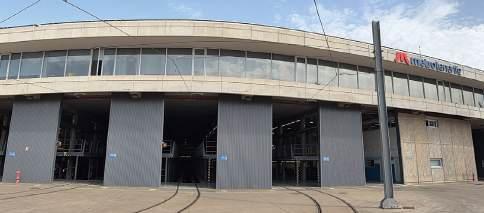
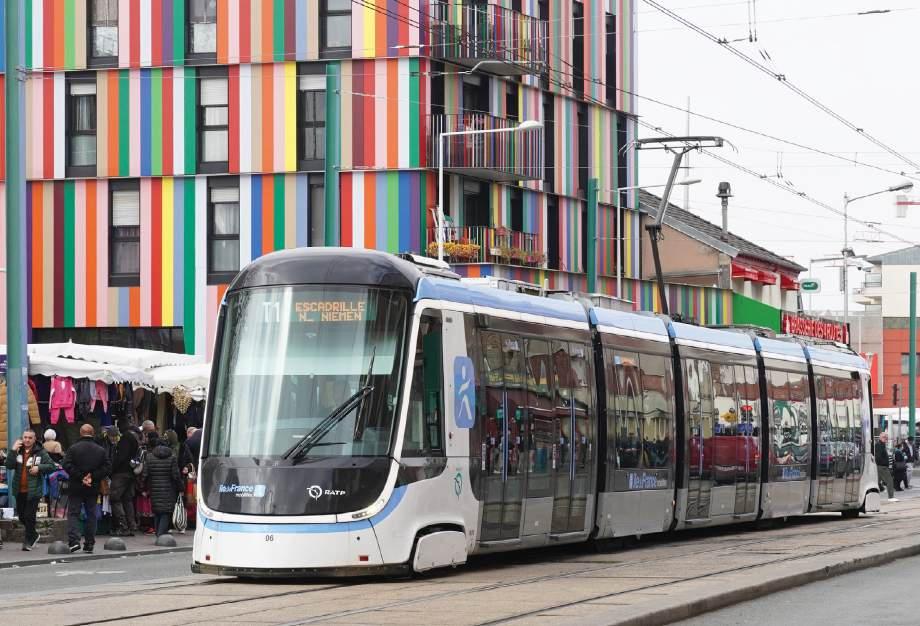
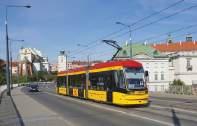
































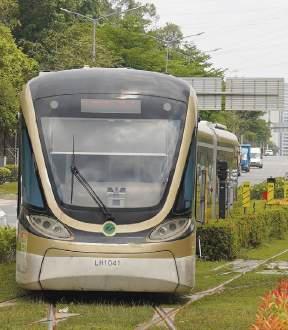
NEWS 408
Wirye tramway undergoes trials in Seoul; Kuala Lumpur opens new elevated metro; Seattle announces opening date for extension; Copenhagen welcomes new line.
JOINING UP PARIS 412
Neil Pulling looks at the development of the Île-de-France Mobilités tram lines T1 and T2, two very different and intensively used orbital services that will shortly be linked.
HANOI’S LASTING LEGACY 417
With the first section of Hanoi’s metro Line 3 now open, Richard Foster asks what impact greater connectivity will have for this country in the early stages of LRT.
WOLTERSDORF FLEET UPDATE 421
Tony Streeter reports on how the new fleet has been settling in to this German town after six months in service.
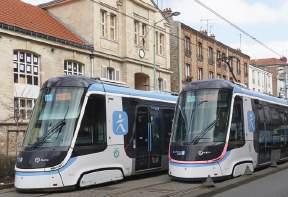
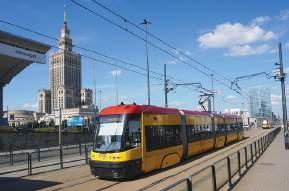
EXPANSION IN WARSAW 424
A system that has never stopped growing: Andrew Thompson explores the largest city in Poland’s sprawling light rail offering.
SYSTEMS FACTFILE: SHENZHEN 429
Small but not insignificant, this Chinese tramway is designed as a feeder for a much larger metro system.
WORLDWIDE REVIEW 434
Finance agreed for more trams for Gera; First G-Class delivered to Melbourne depot.
TRAMFORWARD/UKTRAM 439
Celebrating the industry’s rising stars.
CLASSIC TRAMS:
MINNESOTA STREETCAR MUSEUM 440
The Twin Cities host a small but interesting heritage operation entirely run by volunteers: Mike Russell takes a look.

Although it has only been in power for little over a year, the UK’s Labour government is – like so many around the world – struggling to balance its economy because of unsettling events outside of its control such as the conflicts in Ukraine and Israel/Gaza.
However, it has made the bold step of announcing that ten brand new towns are to be created across the country to cope with population growth. With clean sheets of paper, can we hope that urban transit is incorporated from the very beginning?
Four of the new locations are no-brainers; Tempsford in Bedfordshire, 80km (50 miles) north of the capital, can be linked to the new East West Rail (Oxford to Cambridge); Thamesmead in London can be served by an extension of the Docklands Light Railway under the River Thames; Victoria North in Manchester by a new Metrolink hub; and Leeds South Bank by the new West Yorkshire Tram system.
Someone always spoils it though, and ‘trackless trams’ (are there such things?) have already been suggested to improve public transport in Milton Keynes.
There’s no time to lose in pointing out to planners the folly of their ways.
The Global Light Rail Awards in London on 1 October was a magnificent event (and a complete sell-out) and we will be giving extended coverage of all the winners in our next issue.
Finally, it is with sadness that we report that long-standing LRTA member and world traveller David Young from Holyhead, North Wales, was one of 16 who lost their lives in the Lisbon Funicular accident on 3 September. His family said: “His final moments were in pursuit of the hobby which gave him so much happiness”.
Matt Johnston, Editor

NOVEMBER 2025 Vol. 88 No. 1055 www.tautonline.com
EDITORIAL
EDITOR – Matt Johnston matt@mainspring.co.uk
ASSOCIATE EDITOR – Tony Streeter tony.streeter@mainspring.co.uk
WORLDWIDE EDITOR – Michael Taplin miketap@mainspring.co.uk
SENIOR CONTRIBUTORS –Howard Johnston , Neil Pulling
WORLDWIDE CONTRIBUTORS
Richard Foster, Andrew Grahl, Andrew Moglestue, Herbert Pence, Mike Russell, Nikolai Semyonov, Alain Senut, Andrew Thompson, Witold Urbanowicz, Bill Vigrass, Thomas Wagner, Philip Webb.
PRODUCTION – Lanna Blyth Tel: +44 (0)1733 367604 production@mainspring.co.uk
DESIGN – Debbie Nolan
ADVERTISING
COMMERCIAL MANAGER – Geoff Butler Tel: +44 (0)1733 367610 geoff@mainspring.co.uk
Tramways & Urban Transit 13 Orton Enterprise Centre, Bakewell Road, Peterborough PE2 6XU, UK
Tramways & Urban Transit is published by Mainspring on behalf of the LRTA on the third Friday of each month preceding the cover date.
LRTA MEMBERSHIP (with TAUT subscription) Tramways & Urban Transit is sent free to all paid-up members of the Light Rail Transit Association.
LRTA WEBSITE AND DIARY Tim Kendell webmaster@lrta.org meetings@lrta.org
SUBSCRIPTIONS, MEMBERSHIP AND BACK ISSUES LRTA Membership Secretary (Dept T06), 38 Wolseley Road, Sale M33 7AU, UK. Tel: +44 (0)117 951 7785 membership@lrta.org Website: www.lrta.org FOR CORPORATE SUBSCRIPTIONS VISIT www.mainspring.co.uk
LRTA REGISTERED OFFICE 13 Orton Enterprise Centre, Bakewell Road, Peterborough PE2 6XU, UK Private company limited by guarantee, No. 5072319 in England and Wales.
LRTA CHAIRMAN – Paul Rowen chair@lrta.org
© LRTA 2025
Articles are submitted on the understanding they may also be used on our websites or in other media. A contribution is accepted on the basis that its author is responsible for the opinions expressed in it, and such opinions are not those of the LRTA or Mainspring. All rights reserved. No part of this magazine may be reproduced or transmitted in any form by any means, electronic or mechanical, including photocopying, recording or by any information storage and retrieval system, without prior permission in writing from the copyright owner. Multiple copying of the contents of the magazine without prior written approval is not permitted.
Hitachi opened its new USD100m (EUR85.5m) factory in Hagerstown, Maryland (US), on 8 September. The 28 521m 2 factory can build 20 railway vehicles a month. Hitachi already has an order for 256 8000-series cars for Washington Metro, 78 cars for the Baltimore Metro SubwayLink and 200 for Southeastern Pennsylvania Transportation Authority in Philadelphia (SEPTA).
The new plant has been described as ‘carbon neutral’ and includes USD30m (EUR25.7m) worth of digital and AI technology to “optimise quality and delivery”. It will support 460 new jobs, while contributing USD350m (EUR299m) to the local economy.
Polish manufacturer PESA is to invest PLN500m (EUR117m) in expanding its Bydgoszcz factory. It hopes to double its production capacity of heavy and light rail vehicles by 2027.
Bulgarian runaway Tatra T6 set 4177+4176 was damaged after it ran away on Sofia’s line 22 on 2 September. The tram reached speeds of 80km/h (50mph) before crashing into – and damaging – a pedestrian subway at Tsar Ivan Asen ulitsa.
The incident took place at around 05.00; the tram was empty at the time. No pedestrians were injured, although there were reports that some cars were damaged.
An investigation is underway into how the incident happened. There have been reports that the tram was set in motion while the driver was absent from the cab.
Gold Coast cancelled Queensland’s government (Australia) cancelled the planned 14km (nine-mile) extension to the Gold Coast’s G:line system on 1 September. This would have taken trams from Burleigh Heads (terminus of the underconstruction Phase 3 extension) to Coolangatta, via the airport.
Public consultation closed in May and the decision was made in view of significant opposition. Queensland’s Acting Premier, Jarrod Bleijie, said that other transport options would be explored, including buses. However, Gold Coast Mayor Tom Tate told ABC News that highdensity housing would still be built, with the population increasing from 650 000 to one million by 2040. He voiced his frustration that the project had been cancelled.
“The reality is there will be more buildings going up. People like to live by the coast and it’s the market that’s driving it.”
Service on new 2.2km line began from 1 September
Wiener Linien, the tramway operator in the Austrian capital, chose the first day of the new school term to launch passenger services on the 2.2km (1.3-mile) line 12 extension. The first tram left the new Hillerstrasse terminus at 05.09 on 1 September.
Line 12 formerly ran from an interchange with U-Bahn line U6 at Josefstädter Strasse as far as Rebhanngasse. Now it continues through the 2nd District to Hillerstrasse, via an interchange with Line U1 at Vorgartenstrasse.
The new section has five stops and replaces bus line 11A. It features 100 newly-planted trees and 230m of green tracks, while complementary new cycle paths have been created.
Ulli Sima, City Councillor for Planning & Mobility, said: “Vienna is growing and our

public transport is growing with it. I’m delighted that the work is complete and that line 12 will be serving the people of Vienna as soon as school starts.
“Line 12 combines climatefriendly urban planning with environmentally friendly mobility and brings even more quality of life to the neighbourhood.”
Alexandra Renal, CEO of Wiener Linien, added: “Line 12 is an important new crossconnection through four districts and offers numerous interchange options with the subway, S-Bahn, trams and buses. It will significantly reduce travel times for passengers. We are expecting around 16 000 passengers daily on line 12.”
South Korea’s capital is on the cusp of welcoming trams for the first time since 1968. Testing on the new 5.4km (3.4-mile) standard-gauge Wirye Line is underway, but it is unlikely to carry passengers until 2026.
This street-based, wire-free tramline links Macheon station on metro line 5 to Bokjeong station on metro line 8 via the Songnye entertainment district in Wirye New Town. A branch connects Changgok to Namwirye station on line 8. Woojin Industrial Systems/ HyundaiRotem are delivering ten five-section, 33.9m low-floor articulated trams at a cost of KRW39.2bn (EUR23.8m).
At 2.65m wide, they can carry 161 passengers (66 seated). They

are powered by an onboard fuel cell and have a radar-based collision avoidance system.
The KRW261.4bn (EUR158.7m) project started construction
in 2022. One last major hurdle to opening has been cleared after Seoul Metropolitan Police Agency carried out a safety review on the system.
Kuala Lumpur’s new automated LRT3 metro system was to open to passengers on 30 September.
The mostly elevated 37.8km (23.5-mile) line serves the western side of the Malaysian
capital, running between Bandar Utama and Johan Setia.
Officially called the Shah Alam Line, it will become Line 11 of the Klang Valley Integrated Transit System. There is interchange
with MRT Line 9 at Bandar Utama and with the Kelana Jaya line (LRT5) at Glenmarie.
The fully-automated route has reportedly cost MYR20bn (EUR4bn) to build.
Passenger services started on the 14.4km (nine-mile) Glendora –Pomona section of Los Angeles’ Foothill Extension on 19 September. However, the line, formerly the Gold Line Foothill Extension, will not initially continue beyond Claremont, 3.2km (two miles) from its current terminus at Pomona.
That is because San Bernadino County Transportation Authority voted on 3 September not to fund the 1.9km (1.2-mile)
section from Claremont to Montclair. The vote went 15:11 against the project, due to increasing costs.
Foothill Gold Line
Construction Authority Chief Executive Officer Habib Balian said: “While it is not the end of the line for the Gold Line to reach Montclair, today’s vote was a significant setback, as it results in the Montclair extension not moving forward simultaneously with the Claremont portion of the final project segment.”
Meanwhile, a FlatironDragos and Herzog joint venture has been awarded the enabling contract for the 23.2km (14.5mile) Southeast Gateway Line from downtown LA to Artesia, which will include the creation of extra capacity at Union Station.
The final environmental impact report for the 7.2km (4.5-mile) extension of Line C from Redondo Beach to Torrance Transit Center has been released. This will enable construction to start in 2027.
A shortage of trams arose in Oslo in August after the sand tank at the Norwegian capital’s Grefsen depot was mistakenly filled with gravel. The error was not noticed until tram sandboxes had been refilled; delays caused by having to remove the gravel meant the introduction of the winter (enhanced) timetable has been delayed.
Russian Prime Minister Mikhail Mishustin has ordered the federal ministries to work with the Kaliningrad region to renew old trams and worn-out lines. Proposals to achieve this are to be presented by 1 November.
The Prime Minister became involved in the future of the city’s tramways after being petitioned by local residents. Full modernisation is likely to cost RUR10bn (EUR102m). An order for concrete sleepers has already been placed.
A national day of mourning was declared in Portugal in the wake of the fatal crash on the Lisboa (Lisbon) Gloria funicular on 3 September. The Portuguese parliament passed a vote of condolence while a proposed tram parade for 20 September was cancelled.
The accident took place just before the last issue closed for press. The government’s accident investigation agency GPIAAF’s preliminary report said that the cable broke at its attachment to car 1. At 18.05 on 3 September, the 1885-built vehicle broke away with the resulting crash killing the brakeman and 16 passengers, as well as injuring 23 others.
The preliminary report added that the car’s automatic pneumatic and manual emergency braking on the 265m line, with its 1-in-5 gradient, proved ineffective. The descending car derailed and hit a curve by the Hotel Suico Atlantico at about 60km/h
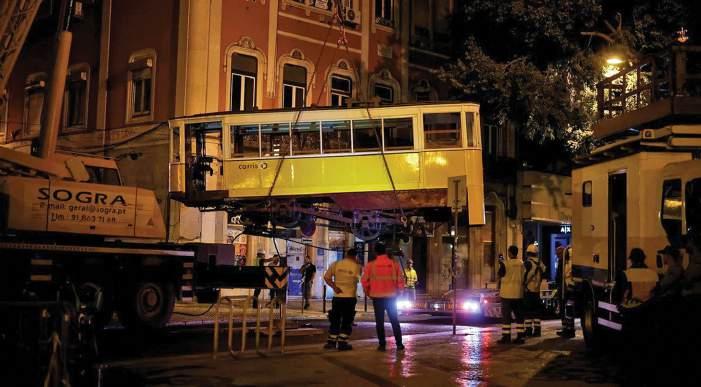
(37mph), the passenger cabin disintegrating. The ascending car (2) fell back a few metres at the lower terminus but passengers disembarked safely.
A full report is expected to be published in the next couple of months, while the service remains suspended and has been replaced by bus 51E.
Other historic funiculars around the country (Bica, Lavra and NAZARÉ as well as the Santa Justa elevator) were suspended for safety checks.
Sound Transit, Seattle’s public transport agency, has announced that passenger services on the Federal Way light rail extension are to start on 6 December. The 12.6km (7.8-mile) southern expansion of the US city’s light rail system will run from Angle Lake to the Federal Way Transit Center, mostly on viaducts.
There are intermediate stations at Kent Des Moines and Star Lake.
Services will be provided by north-south Line 1 operating from Lynnwood City Centre via downtown Seattle and Sea-Tac airport, with a six-minute peak headway. Line 1 is operated by three-car trains of Siemens S700
LRVs capable of carrying up to 582 passengers (222 seated).
Seattle opened the first part of Line 1 in July 2009, the route sharing the Downtown Seattle Transit Tunnel with trolleybuses. The Federal Way extension project began construction in early 2020 at a cost of USD2.55bn (EUR2.2bn), with a federal grant
of USD790m (EUR675m). The extension brings the line to 65.6km (40.8 miles) in length.
The next extension to the system is due to come in early 2026 when the 18-mile (29km) Line 2 starts to use the missing link between South Bellevue and downtown Seattle. Initial test runs took place on 8 September.
Canada’s Toronto Transit Commission has identified a CAD11.9bn (EUR7.3bn) shortfall for state-of-good-repair work over the next 15 years and is requesting that the city, province and federal government all provide funds to avoid service disruptions. Line 504 has been particularly affected by deteriorating infrastructure.
Intersections at Broadview
Zürich tram operator VBZ is to reorganise its network from 14 December to allow the Bahnhofquai stop to close for a planned year-long refurbishment. The Swiss system is then to look like this:
• Line 4 (created by linking lines 11 and 13), Albisgütli –Bahnhofstrasse – Rehalp
• Line 6 (linked to line 14 at Bahnhofplatz), Zoo – Triemli
• Line 11 (former line 15), Tiefenbrunnen –Bahnhofstrasse
• Line 17, Werdhölzli –Bucheggplatz
• New (temporary) line 50, Frankental – Auzelg
• New (temporary) line 51, Altstetten – Seebach
Avenue and Queen Street East, and Dufferin Street and King Street West, will be closed throughout October for work. This comes after a report revealed that only 57% of Line 504’s services were on time.
“People know that they can’t rely on the streetcar and that’s a dangerous place to be”, said Andrew Pulsifer, Executive Director of the advocacy organisation TTCRiders.
“We need more money put into the system.”
“If we don’t maintain and keep this system upgraded, it’s more prone to failures”, said TTC spokesperson Stuart Green.
Meanwhile it appears that the Finch West light rail line will be the next Toronto light rail line to enter service. It was handed over to TTC on 6 September and should open after completion of its 30-day service simulation.
The Eglinton Crosstown project was not able to start its revenue service demonstration as planned in September, leaving an opening date uncertain.
Trillium Rail Partners has been appointed by Metrolinx to design and build the seven stations and rail infrastructure for the 9.2km (5.7-mile) Eglinton Crosstown West Extension project from Mount Dennis to Renforth Drive.
The Danish capital København (Copenhagen) should soon be on a par with the provincial cities of Aarhus and Odense as it plans to welcome its first new tram system on 26 October. Travel is due to be free on the first day of tram service on the 13.1km (8.1-mile) Ishøj to Rødovre Nord line.
The standard-gauge line, which cost DKK6.2bn (EUR831m) to build, broadly follows the Ring 3 motorway north to south. Three of its 12 stops will provide interchange with the radial lines of the S-tog rapid transit system. Known as the letbane, the new tramway uses 29 Siemens Avenio 36.9m low-floor trams, which were built in Serbia.
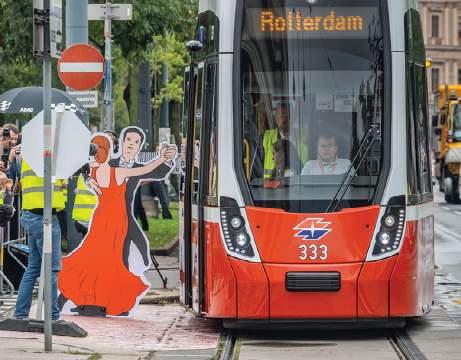
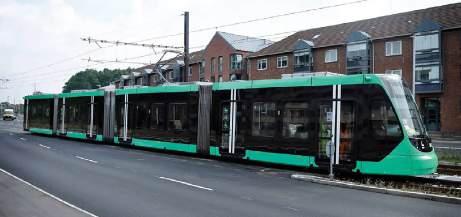
Initial frequency is every ten minutes (eight minutes at peaks), but a five-minute peak headway is planned and 10m passengers/ year are expected, increasing
to 13m within five years.
The Rødovre Nord – Lundtofte section should open in spring 2026, bringing the total length up to 28km (17 miles).
The TRAM-WM World Tramdriver Championship has been won by Elisabeth Urbanitsch and Florian Isaku from Wien (Vienna). The event was held in the Austrian capital on 13 September, when teams from 25 countries competed.
Previously a European event, 2025’s competition was expanded to include drivers from Africa (Casablanca), North America (San Diego), Asia (Hong Kong), South America (Rio de Janeiro) and Oceania (Melbourne). Great Britain was represented by a team from Edinburgh Trams (Kira Sutter and Jason Moffat).
The competition involves the teams carrying out seven driving trials: stop-and-go without spilling water; speed and target braking; tram bowling (pushing a large ball with a tram into inflatable skittles); precision reversing; lateral distance from an obstacle; exact stop and tram curling (push a trolley as far as possible). All drivers used Wien ULF (72) and Flexity (333) trams. The competition took place on the Ring outside the Burgtheater and Rathaus (City Hall), with services diverted. Thousands of spectators watched.
Next year’s competition is to be held in Melbourne.
Russian capital plans 90% shift to automated technology by 2035
After months of trials and training, a fully automated, driverless tram entered passenger service in Moscow on 3 September. PKTS-built 71-911EM Lvyono bogie vehicle 30618 is now running on line 10 in the Russian capital’s north-west suburbs from Ulitsa Kulakova to Metro Shchukinskaya.
With six cameras, four lidar and three radar systems, the tram uses 3D technology to create a precise map of its surroundings for navigation and identification of objects. The software, developed in house, has performed for over 8000km (4970 miles) without violating traffic rules. There is a member of staff onboard in case of emergency.
Moskva mayor Sergei Sobyanin said: “This is an important milestone in technological development. Autonomous technology is now being implemented in Moscow’s public transport system. The software for the autonomous tram was developed by Moscow Metro employees without the involvement of third parties. This intelligent technology is unique: it operates more accurately and reliably than its foreign counterparts.”
The city plans to equip three further trams for autonomous running by the end of the year and more than 300 by 2030. It is hoped that, by 2035, some 90% of the trams in the city will use automated technology.
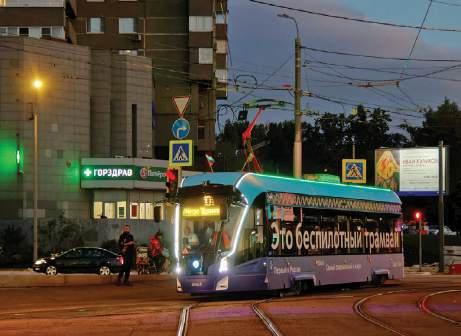
West Yorkshire Combined Authority (UK) has approved the release of GBP40.5m (EUR46m) to help push through West Yorkshire Mass Transit’s Strategic Outline Case. This brings the total invested in WYMT to also develop the Outline Business Case and the Transport & Works Act Order applications to GBP121.4m (EUR137.7m).
It is hoped that the Strategic Outline Case will be submitted in March 2026, with establishing
works starting in 2028. Major construction could start in 2029.
The paper put to WYCA for the additional money said: “In continuing to manage these challenges, to maintain due diligence and de-risk the programme, the necessary time will be taken to ensure work is undertaken as meticulously as possible. This will mean moving the submission of the updated SOC and public consultation while continuing preparatory
work for the Transport and Works Act Order (TWAO) and the Outline Business Case.
“This approach will significantly de-risk the programme by providing more time to finalise the preferred Phase 1 route in response to advice from Kings Counsel. The need to ensure both the TWAO application and the supporting business case are robust and comprehensive remains the programme’s primary focus.”
The Czech capital Praha (Prague) might have celebrated 150 years of its trams on 21 September, but its system continues to evolve. Prague Integrated Transport (PID) has unveiled plans for a 1.8km (1.1-mile) extension to the Mod ř any – Libuš line that
opened in 2023. Construction of the extension to Nové Dvory, where there will be a loop, is to be completed in 2027 at a cost of CZK1.4bn (EUR57.6m).
Meanwhile, a tender has been invited for an extension to link Žižkov with the city
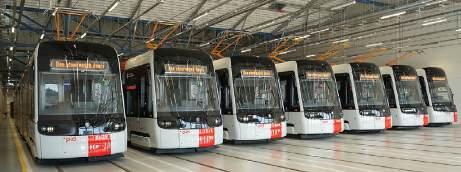
boundary using the alignment of the disused Žižkov – Malešice railway. Construction on this 2km (1.2-mile) tramway is due to start next year, with completion in 2027. The estimated cost is CZK709m (EUR29m).
The Central Bohemia Transport Association has also commissioned AVG Karlsruhe and TTK to carry out a feasibility study for tram-train operation in the Praha region.
LEFT: The 150th anniversary celebrations on 21 September included a grand parade of 42 tram vehicles and sets, including seven Škoda 52T trams. They line up at Hloubetin depot.
A. Thompson
French expansion
Construction of light rail in France continues, with three new projects making progress. In the Norman city of Caen, the public inquiry into plans for two additional tramlines is to close on 16 October. This EUR288.5m project would require 9.1km (5.7 miles) of new infrastructure.
Consultation has started in Dijon on plans to build a third line, from Cap Nord to Chenove Portes du Sud. Costing EUR200m, this 7km (four-mile) line could open in 2030. On the island of Réunion, a partnership of five municipalities has been formed to revive the EUR3bn tram-train proposal that was abandoned in 2010. The first section would link Saint-Paul and Saint-Denis. This 41.5km (25.8-mile) line would include 12.5km (7.8 miles) of tunnels.
The future of trams in Plauen, Germany, has been threatened over the level of subsidy received. Disagreement has emerged between Vogtland’s regional council and the city council. More than 10 000 people have signed an online petition in support of the tramway; the petition was launched by operator Plauener Strassenbahn GmbH on 9 September.
A new route network came into effect on 2 September, all with 15-minute headways: line 1 (Reusa – Preisselpöhl); line 2 (Waldfrieden – Plamag); line 3 (Neundorf –Oberer Bahnhof); line 4 (Südvorstadt – Neundorf).

With the Île-de-France Mobilités tram lines T1 and T2 scheduled for a connection, Neil Pulling looks at the development of these very different and intensively used orbital services.
LEFT: An Alstom Citadis 302 pair draws away from the commercial La Défense district, also a major transport hub, on 28 March. This northern street-based T2 section leading to Pont de Bezons terminus opened in November 2012.
Now represented as Île de France Mobilités (IdFM) tram lines 1 and 2 (T1, T2), these routes were identified more as Paris services when opened in 1992 and 1997. As with most of the now many IdFM T-designated services, these bidirectional 1435mm-gauge tramways were built outside the central area, variously with a mix of suburban settings and areas of a more inner-city nature. Opening in 2006, T3 –later enlarged as T3a and T3b – are, however, within the central ‘Paris Ville’ which is both a commune and a département, the third tier of French administration. A proportionally small part of T2 is located here, but most is in Hauts de Seine. Also present in that département, T1 runs mainly in Seine Saint Denis. Each line has about 18km (11.3 miles) of revenue route, although the more advanced of two active projects will make T1 much longer and take it just into Val de Marne. This will complete a T1-T2 presence in the three départements of the ‘Petite Couronne’ (Little Crown) which immediately borders Paris Ville. These four account for about 6.4% of Île de France region’s area and 56% of a 12.3 million population. As at their openings, T1 and T2 are run by the main Paris public transport operator, RATP. Competitive tendering for IdFM services is due to apply to the two lines from 2029.
Central Paris ended tram services by the late 1930s. The decision to re-introduce them was influenced by a still sparse metro presence beyond Paris Ville in the late 20th Century. The cost of expanding that mode sufficiently for journeys wholly or partly within the outer districts was then seen as prohibitive. Political power shifts brought alternating pro- or anti-tramway decisions, some causing delays to already advanced projects. In 1990 construction began on a curving south-east 9km (5.6 miles) of route for T1 from Saint Denis – due north of central Paris – to Bobigny commune, then and still the site of T1’s only depot. This section opened in two stages during 1992, largely within dedicated space taken from existing streets. The tracks were variously installed amongst high-density residential districts or along suburban main roads.
A 6.6km (4.1-mile) eastern addition in 2003 settled T1 for nine years as a service between termini near Noisy le Sec and Saint Denis main line stations, respectively on main lines from Gare de l’Est and Gare du Nord. T1 also had interchanges with the ends of radial metro lines 5 and 7, later adding rubber-tyred Translohr system T5 (2013) and conventional tram T8 (2014) in Saint Denis. Continuing an orbital path, T1’s westward extension in 2012 included shared road space for crossing the Seine island, Île Saint Denis, plus a track divergence for narrow streets in Gennevilliers. It also added connections with another metro (line 13’s AsnièresGennevilliers Les Courtilles, opened four


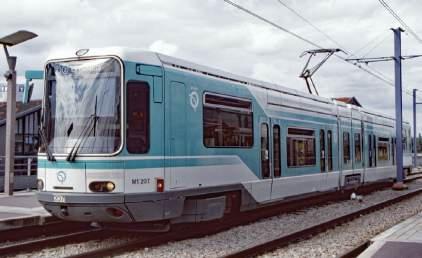
LEFT: Looking north along T2’s formerly heavy rail alignment near Belvédère towards La Défense. Alongside the T2 stop at Puteaux station in the distance, the railway hosting Transilien line L from Paris Saint Lazare is on top of the embankment to the left.
All images courtesy of Neil Pulling.

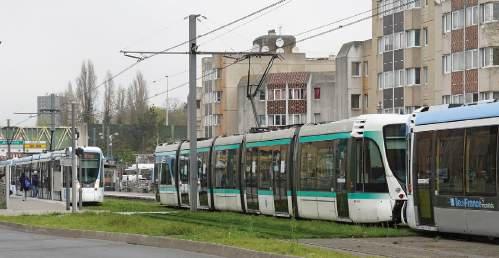
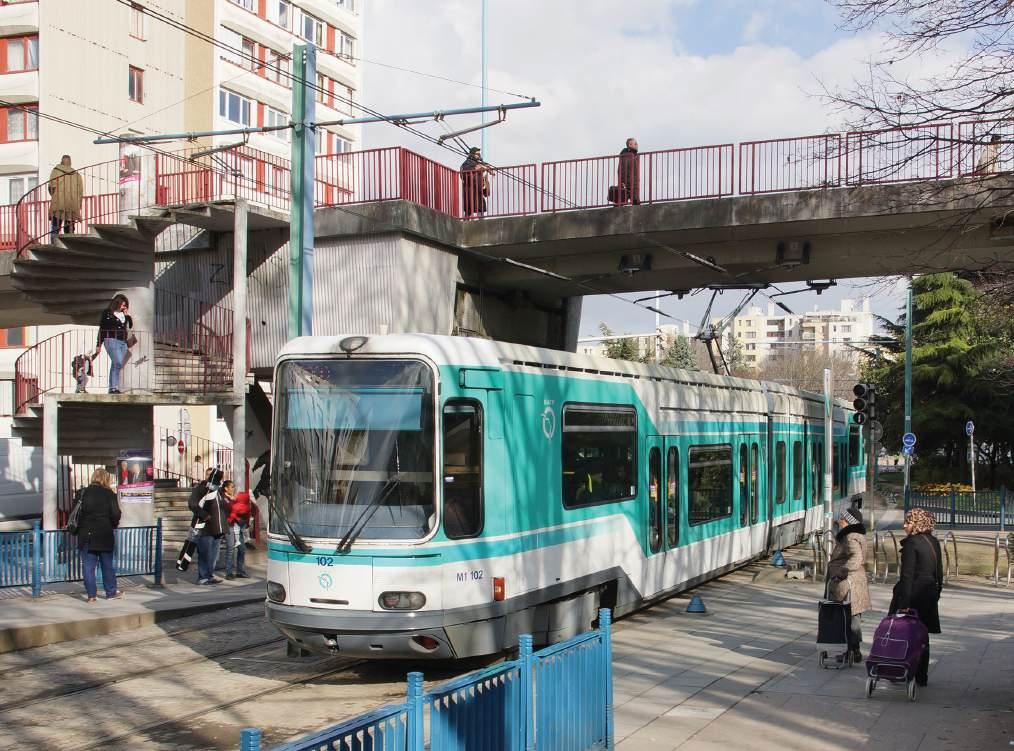
“The T2 project emerged from studies begun two decades earlier for making better use of the Ligne des Molineaux railway.”
years earlier) and the elevated Gennevilliers RER station. Asnières-Quatre Routes became the western terminus in October 2019. The future Grand Paris Express lines, now designated as metro, will add multiple interchanges with the dispersed IdFM tram services. Including a complete circuit, the 75km (47-mile) M15 and a by-then expanded T1 will gain six such points.
Although the T2 building works began three years after those for T1, the T2 project emerged from studies begun two decades earlier for making better use of the Ligne des Moulineaux’ railway – the name a reference to early flour mills – which shadows the meandering left bank of the Seine. The loss of Renault factory freight further reduced this line’s viability, but with major demand generators created at either end plus affluent communities in between, a case for retaining a passenger service was clear. The northwestern business district begun in the late 1950s, La Défense, was set for much more growth, as was the more technology-based Val de Seine counterpart to the south. Conversion to T2 followed the end of heavy rail services
in May 1993. Like the later T3 scheme, the studies for T2 considered re-using some of the largely abandoned Petite Centure orbital railway: neither tramway did so.
The initial Issy-Val de Seine to La Défense section has reminders of the railway inheritance such as station buildings, tunnels, bridges and some decorative signage, but the main prize was a largely unimpeded right of way. The T2 stops here are also more widely spaced than on T1 or on the T2 additions. The first of these was in the south, running from Issy-Val de Seine (also with an RER line C station) to Porte de Versailles in July 1997. This lowered track from the railway alignment and onto the streets, also adding stops inside Paris Ville, with Porte de Versailles T2 terminus close to the T3 (later T3a) stop. Tracks were not connected due to different stock widths on the two lines.
Adding more street running and taking the total number of stops to 24, the more recent T2 addition was 4.2km (2.6 miles) added beyond La Défense to Pont de Bezons in November 2012. This section also included a second depot off a non-revenue spur near Parc Pierre
Lagravère. This compact site supplements the original facility which stretches almost the full distance between Les Moulineaux and Jacques-Henri Lartigue stops.
Motive power was something that T1 and T2 had in common at their openings: subsequent changes reflect the popular reception of the two services and also the pace of change on French tramways. Both lines opened with the Alsthom-GEC TFS-2 This had replaced the original Tramway Français Standard (TFS), a rapidly superseded type that in a modified form was only used on the Nantes system (opened in 1985). The 29.4-metre long, 2.30-metre wide TFS-2 with approximately 70% low-floor area equipped the new Grenoble system in 1987. Established as a proven type of French manufacture, TFS-2 was deemed suitable to meet anticipated demands on the forthcoming Paris lines. Numbers 101-117 were delivered for T1 from February 1992, with 1995-96 builds 118-119 and 201-216 going to T2. With both lines soon exceeding anticipated ridership, a new fleet was ordered for T2. Alstom’s TFS-2 successor was chosen,
with the Citadis by then the fully lowfloor 30-metre 302 variant. With the RATP classification TW01, trams 401-466 arrived in batches between 2002 and 2015, with paired running becoming standard from 2005. Enabled by Citadis arrivals, in 2003 the T2 TFS-2 stock – unable to run in multiple – were transferred to T1, which also needed to run more services. The combined TFS-2 fleet then ran all T1 services until the debut of Alstom Citadis 305 (TW20) trams in December 2024. Commissioning the 37 in IdFM’s initial order (options exist for 83 more) would allow full TFS-2 withdrawal during 2025. The fivesection, 33-metre long and 2.4-metre wide TW20 brought a 15% capacity increase over its predecessor, full air conditioning and a far higher level of passenger information; easier passenger circulation is also evident.
In 2024 IdFM announced funding for seven Citadis 302 (TW10) from T7 and T8 being transferred to T2. Differing from the T2 Citadis, they need modification for T2 multiple operation. A joint IdFN/RATP September 2023 report acknowledged that Citadis tram stock is not ideal for T2 however, with the transfer being represented as an interim measure pending complete fleet renewal by 2035. Opening in 2006 to the east of Paris, T4 was also a heavy rail conversion but used tramtrain stock from the outset, continuing to do so after adding street-based route in 2019. A series of infrastructure modifications since 2022 have incorporated capacity-related measures and improved surroundings, with the relocation of Gare de Saint Denis stop a notable example. In April 2025, T1’s eastern end re-opened after major works between Bobigny-Pablo Picasso and Noisy le Sec.
On T2, rebuilding Porte de Versailles terminus to segregate arrivals and departures plus creating space for holding stock has brought a ten-month closure, due to end by February 2026. The T2 presence in the multimode, multi-level transport interchange beneath La Défense remains challenging for operators and passengers. Redistributing use of the platform space, creating a third platform face and creating a new stop (Rose de Cherbourg) just south of the sub-surface area are amongst potential measures to, as IdFM terms it, de-saturate the prevalent overloading.
Line T1 is being lengthened significantly at both ends, with a 7.7km (4.8-mile), 15-stop south-eastern extension from Noisy le Sec to Val de Fontenay expected to be complete by 2028. Due for later completion, the active Asnières to Colombes project includes the already open stretch to Asnières-Quatre Routes. The 6.4km (four-mile) addition will include a brief section of track shared with T2 at Parc Pierre Lagravère, just before turning off to Petit Colombes terminus. A longer-term objective is adding 7.5km (4.7 miles) west from here to Rueil-Malmaison. Contrasting with these positive aspects, in May 2025 a river vessel hit the L’Île-SaintDenis bridge, with the ensuing closure to all road traffic effectively returning the T1 service to its 2003 coverage. Bus replacements – also stopping short of the bridge – are now expected to last until summer 2026.
A network map can be found online at: www.iledefrance-mobilites.fr/en/le-reseau/plans
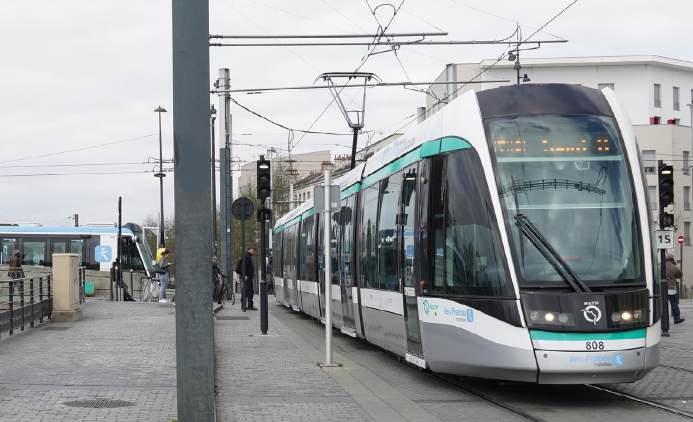

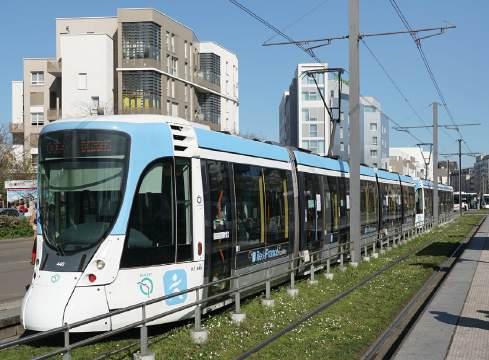
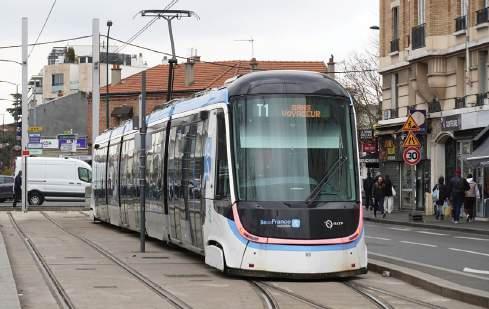
ABOVE: In 2024 IdFM announced that seven Citadis 302 trams drawn from other lines would be modified to increase the T2 fleet: T8’s 808 is at the intersection of T1 and T8 by the Saint Denis canal in March 2025.
LEFT: La Défense’s T2 island platform sees extreme crowding at peak times, with boarding and dispatch overseen by marshalls; options to address service oversaturation are being considered.
LEFT: On the only public transport fixed link for Bezons commune in Val-d’Oise département, the outer faces of Pont de Bezons terminus platforms are used by connecting buses.
LEFT: The future connection with T1’s western extension, Asnières-Quatre Routes became the new terminus in October 2019. A river bridge strike in May 2025 is expected to continue T1’s suspension between here and Gare de Saint-Denis until summer 2026.
Unlock your light rail potential with this unique eco-system which provides all the information insight intelligence that you need to make the right global light rail market decisions.
Instantly access the intelligence that you need to accurately gauge the current size of the market
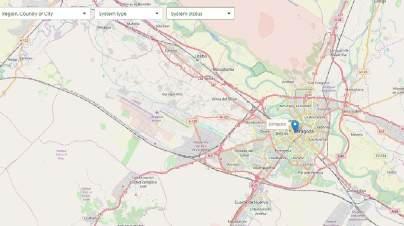
Immediately identify, target and communicate with your next key clients... wherever they are in the world

Constantly updated and verified news and information on each system from trusted industry sources
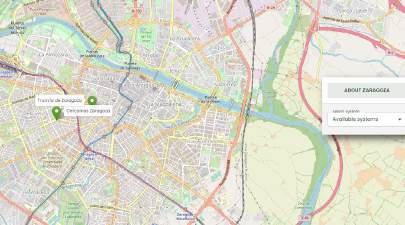
Explore detailed city and system information for each system including keybenchmarking figures
Forecast your next moves within the market by accessing current tenders, competitor activity and market share
Every line and station of every global system accurately plotted down to line and station level

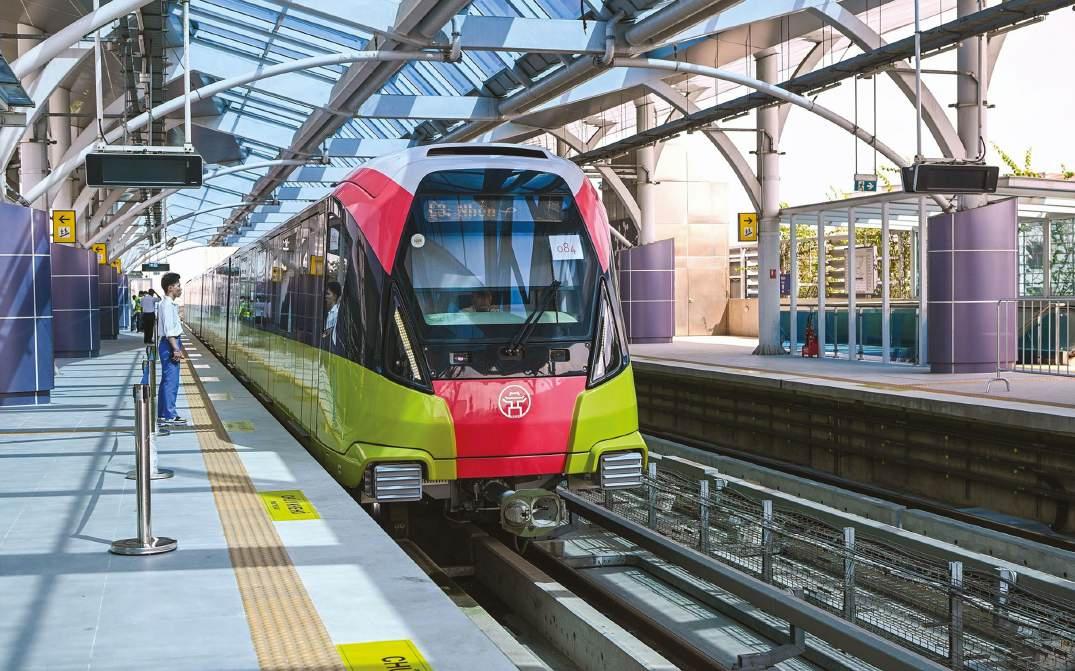
The opening of Line 2A in 2021 heralded Vietnam’s first metro – now, with the first section of Line 3 up and running, Hanoi is reaping the benefits of connectivity. Richard Foster looks at what the metro promises for this growing city.
“
We have been excited since last night, couldn’t sleep, just waiting for morning…
We left for the station very early. I found this train fast and comfortable. I got to see high-rise buildings and modern roads. The train also passes many universities, it will be very convenient for the students to go to school.”
Mrs Bui Thuy Son is just one of the 1.6m people in Hanoi who, from 8 August 2024, found themselves with a state-ofthe-art public transport system on their doorstep, offering hitherto untold levels of connectivity around Vietnam’s capital city. Who wouldn’t be excited by that prospect?
What opened last summer was the first 8.5km (5.3 miles) of Hanoi’s metro Line 3. It’s perhaps easy to be blasé about the impact the opening of such a line could make because, in many countries, most towns and cities have decent levels of connectivity, even if some like the UK have a paucity of light rail.
If you take London as an example, its urban rail network has been growing steadily for 162 years. Hanoi has only been the capital of the Socialist Republic of Vietnam since the country came into being on 2 July 1976. Its first metro system opened as recently as 2021. The gloss hasn’t even worn off yet. There’s one underlying driving force in
any modern railway construction project – be that light or heavy rail - and that’s leaving a legacy. What we build now should ultimately benefit the generations that come after us.
Legacies come in many forms. Yes, improved connectivity is one. And improving the environment is becoming an increasingly strong factor, too. But there are others and Hanoi metro’s Line 3 is a good example.
Hanoi is typical of many cities in Asia. It’s vibrant and rich in culture, influenced by key periods in its history, when it was part of Chinese and then French imperial aspirations, followed by decades of independence. Sadly, the westerner’s view of Vietnam will be tainted by the war that raged between 1955-75 that has heavily influenced popular culture.
But that vibrancy and richness comes with a price. There are 8.8m people living within the city’s 3359km 2 (1297 square miles). The majority of citizens get about using motorcycles. Car ownership is still something for the affluent: across Vietnam, published statistics show 68 cars per 1000 people, although ownership is on the increase. Some 9% of Vietnamese households now own a car. That was 3.3% in 2019. Consequently, at the
time of writing, the city was topping global charts for poor air quality.
Vietnam’s government backed a vision to build metro systems as far back as 1998. It took until 6 November 2021 for the first to open. This was Hanoi’s 13.1km (8.1-mile) Line 2A that runs diagonally northeast –southwest from Yên Ngh ĩa to Cát Linh. This was built by China’s CRRC. Work started in 2011 but there were myriad delays, and the cost rose from EUR472m to EUR742m.
That doesn’t seem to have tainted Line 2A now that it’s open. The 80th anniversary of the founding of Ho Chi Minh’s Democratic Republic of Vietnam on 2 September resulted in 165 000 people using it, a record number. Possibly the offer of free travel between 30 August and 2 September provided an inducement for many!
Building Line 3 took a different approach. The civil engineering work was undertaken by a mixture of South Korean and Vietnamese contractors while a consortium of Alstom, Colas Rail and Thales took care of everything else.
Of those companies, Alstom built the ten four-car trains based on its Metropolis platform. It also installed its Urbalis 400 communications-based train control system. Thales was responsible for a complete telecommunications system.
Colas was awarded three lots: supply and installation of trackwork and third-rail; installation of the the power supply and depot equipment, which involved close collaboration with Alstom; and all electromechanical systems at Line 3’s 12 stations (RATP Smart Systems of France supplied the ticketing system).
Modal shift that lasts
As originally envisaged, Line 3 was to be 12.5km (7.8 miles) long. It would run eastwest from Nhổn to Hà Nội railway station and of its 12 stops, eight would be on the 8.5km (5.3-mile) elevated section while the remaining four would be underground. The line would provide connectivity to 1.6m residents (approximately 20% of Hanoi’s population). The aim was to achieve modal shift, Colas describing it as turning the city’s roads “from chaos to calm”. Reducing traffic congestion would, therefore, have a positive knock-on effect on air quality.
The European Investment Bank contributed EUR141m to the scheme, with the bulk of the funding coming from the Asian Development Bank, amounting to EUR349m.
EIB Vice-President Nicola Beer said, “Once fully operational, Line 3 is expected to serve up to 90 million passengers annually, helping to boost public transport usage in Hanoi from 15% to 40% and bringing Vietnam closer to its net-zero emissions goal by 2050.”
Line 3 was designed to cope with 23 900 people a day. Some 34 000 people turned out for the opening ceremony, and it was reported that 500 000 people used it within the first ten days of opening. Vietnam News reported on 9 August 2025, “[The] Department of Transport said the line has carried over 6.4 million passengers since it began operation… The service averages between 19 000 and 21 000 riders per day, with more than 7600 trips completed over the past year.”
We won’t fully know what sort of an environmental legacy Line 3 is to leave for some time. Hanoi’s city government vowed in 2017 to restrict the use of motorbikes within the city centre by 2030. However, Hanoi’s worsening air quality situation – dubbed ‘Airpocalypse Now’ by some tabloids –forced Prime Minister Pham Minh Chinh to implement a ban on petrol-powered bikes that’s due to come into effect from 1 July 2026. However, some commentators have suggested that in order for the ban to succeed, more residents need access to public transport, so that it accounts for 30%-50% of daily travel needs. At the moment, the figure is below 20%.
Even Line 3 doesn’t reach all the people it was planned to reach. That’s because tunnel boring didn’t start on the underground section until 30 July 2024, a few weeks before the elevated section was ready to open. Line 3 won’t reach its full 12.5km (7.8-mile) length until at least 2027. The Tunnel Boring Machines are steadily cutting their way beneath Hanoi to reach its main railway station. But even at the time of writing, heavy rain was causing what’s been described as “foamy mud” to bubble up from the tunnels. This mud has caused chaos on
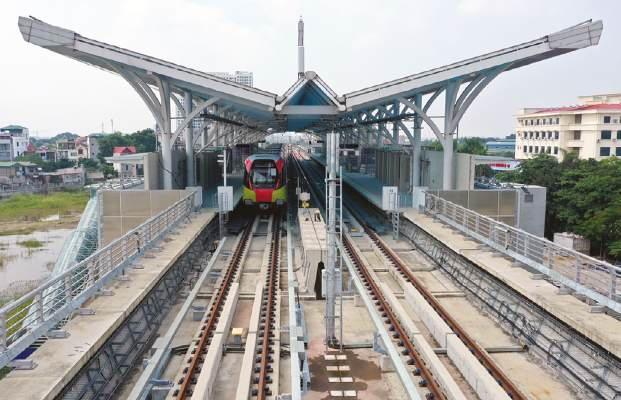
the surface and has had to be removed by a fleet of road tankers.
That said, the signs for what Line 3 can bring to Hanoi are already positive. Vietnam News added that average punctuality for the year was 99% while customer service was, according to Hanoi Urban Transport Management and Operation Center, rated at 99.9%. It also reported on levels of integration that could put some European cities to shame, now that 36 bus routes have been connected to the metro. Cầ u Giấy interchange has been remodelled to enable it to cater for “6000 passengers per hour in each direction”.
Following consultation and collaboration with the client, additional infrastructure –in the form of diamond switches and crossings at the end of the elevated rail –was put in place to split the elevated and underground sections of the scheme. This presented a challenge to Colas’ design and delivery team. With the viaducts already built, could they handle the additional superimposed loading of the switches and crossings? Through engagement with the client, a change request approval was initiated, assessing the feasibility, impact, costing and potential risks.
This, it says, is indicative of its “proactive approach”. And it has clearly worked, for it enabled this stretch of line to be opened three years before the proposed 2027 opening date. This effort was recognised by the judges of the 2024 Global Light Rail Awards when it was named winner of the Project of the Year over EUR50m category.
While Line 3 is not yet complete, opening the elevated section is now bringing 21st Century metro travel to more residents than ever. These are people who would otherwise have had to wait for years for the metro, suffering disruption but not gaining any of the benefits.
So what of Line 3’s other legacies? Colas is proud of the fact that it brought a European safety culture to Hanoi Metro. Colas quotes Vietnam’s Department of Labour Safety,
where, “in the first six months of 2023, there were 2931 accidents, 281 fatalities and 715 serious injuries” across the country as a whole. It is significant then to note that, from the start of 2024 until the line opened in August, Colas’ Lost Time Injury graph – i.e. one that records time lost due to injury – was zero. Observation of unsafe practices also fell to reach Colas’ target of one safety observation per 500 hours worked.
In fact, in the 2.8 million work hours that Colas staff and sub-contractors spent on metro Line 3 over ten years, there were no fatalities, no lost time incidents, and only 791 safety observations. To bring Colas Vietnam’s safety culture in line with British and French practices required “training, behavioural safety programmes, monthly refreshers and regular monitoring to improve safety performance”.
Safety, of course, is a culture. But Colas was able to bring a wider change of culture than just safety.
Line 2A was the country’s first metro system. The second, the 19.7km (12.2-mile) metro across Ho Chi Minh City, only opened on 22 December 2024. With the first phase of Hanoi’s Line 3 open, there’s now just 36.3km (23 miles) of metro across a country that covers 331 000km 2 (128 000 square miles). Consequently, the pool of expertise in metro construction and operation was somewhat small.
Colas set about forming a pool of local talent, who would gain experience from engineers from across Colas Rail’s global portfolio. It joined forces with three leading engineering universities across the country –University of Transport & Communications, Hanoi University of Civil Engineering and Electric Power University – to “share best practice, create internships and employment opportunities”. The result was that 25 internships at Colas were awarded to students to “provide them entry-level

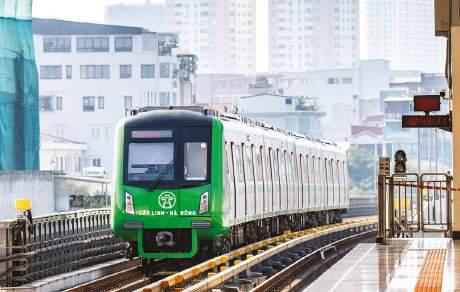



experience in urban rail engineering”. Five of these interns are now working for Colas. Says Minh Manh Hoang, now a Colas Rail Track Work Project Engineer, “My teamwork skills and team management skills improved when I was given first chance to lead a team. This project also helped me gain more knowledge about project management, which the university didn’t focus on deeply.
“At Colas Rail Vietnam, our health and safety, work-life balance and stress relief are always being cared for through annual training sessions and meetings. The company also believes in the importance of diversity… This brings more opportunities for employees like me to work in other projects around the world. We are encouraged to come up with new ideas for a more outstanding output.”
The statistics for Colas’ involvement are impressive. When track is finally laid in the tunnels, it will have put down 32.2km (20 miles) of rail, including the sidings in the depot at Nhổn. That includes 44 switches and crossings. It will have laid 100km (62 miles) of 22kV power distribution through 20 sub-stations. Once the 12 stations are complete, Colas will have installed 44 lifts and 68 escalators.
This work alone has created an additional 800 jobs for local people. In total, including its own interns, Colas has trained 85 engineers thanks to its Line 3 contract.
Nga Duong, Colas Rail Document Controller, sums up the legacies that Line 3 is likely to leave: “I’m happy to be one of the beneficiaries of this project. I can take a train to Cau Giay station, then take a bus to the office. It shortens my journey… and, most importantly, I can enjoy a safe and clean mode of transportation.
“My son can go to school by metro too. The training on railway safety conducted by Colas Rail Vietnam to the students of my son’s school is much appreciated. The students are equipped with [a] safety mindset.”
Chinese wage increases mean that companies such as Nike and Apple are moving production to countries such as Vietnam, and the use of concrete in huge construction projects – when combined
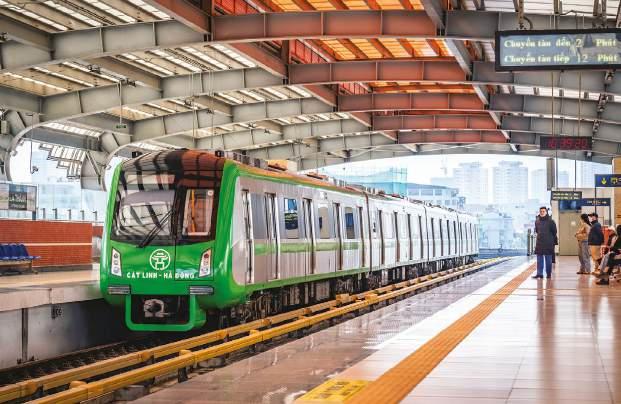
with the road traffic – is helping maintain Hanoi’s position as the world’s most polluted city.
Vietnam aims to become carbon neutral by 2050. Commentators fear that will not be achievable without massive investment, which the country is not currently in a position to afford.
However, light rail is to become a vital tool in Vietnam’s bid to improve its environmental fortunes. Ho Chi Minh City’s metro could become 510km long (317 miles) if plans come to fruition.
Meanwhile, Hanoi’s metro system is expanding. The tunnel boring machines, foamy mud aside, are making progress.
TBM Th ầ n Tốc (Flash) reached the Station S11 (Vă n Miếu) box on 28 July 2024 completing 80% of its 4km (2.5-mile) journey. The station ‘boxes’ are finished and a 2027 opening is still on the cards.
Ground breaking on the first part of Line 2 could take place as early as October. This would link Nam Thă ng Long to Trầ n Hư ng Ð ạo, a distance of 11.5km (7.1 miles). Of that, 8.9km (5.5 miles) will be elevated and 2.6km (1.6 miles) underground. It’s to have ten stations and is expected to cost VND35.6tr (EUR1.2bn). It could open in 2032.
Then, in December, work should commence on the 38.4km (23.9-mile) Line 5. Connecting Vă n Cao to Hòa L ạc, the bulk of
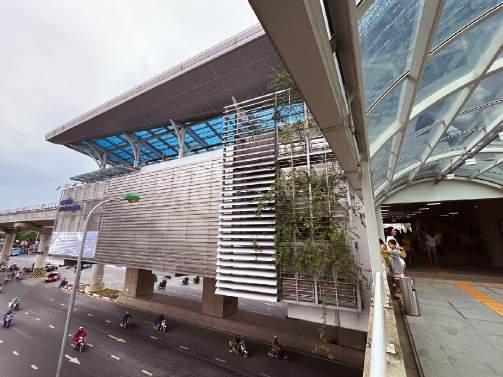
this line will be ground-level. Approximately 6.5km (four miles) is to be underground with 2km (1.2 miles) at elevation. There are to be 21 stations and two depots. It is not clear when this line could open but it’s expected to cost VND61.9tr (EUR2bn) to build.
Construction of these two lines is the first step towards the Vietnamese government’s desire to build 14 new lines across the city. The ultimate aim is to reduce traffic congestion and thus pollution. These 14 lines would form a 550km (342-mile) network leaving few areas of the city without access to public transport.
Another important legacy that light rail can leave is an improved economic position. Financial consultancy firm JLL reports that transit-orientated development, where new developments are within 1km (0.6 miles) walking distance to public transport, are bringing economic growth to both Ho Chi Minh City and Hanoi. It said, “Developments within a ten-minute walking distance of metro stations have experienced substantial price appreciation following the commencement of metro operations – approximately USD200-250 [EUR170-212] per square metre over a one-year period. This translates to annual growth rates of 8% for metro-adjacent properties compared to 4% for the broader market in [Ho Chi Minh City] during [first half of 2024 to first half of 2025]. In Hanoi, the differential was even more pronounced.”
Chairman of the Hanoi People’s Committee, Tran Sy Thanh, said that Line 5 is one of three key infrastructure projects that will help the city reach its 8% growth target.
How much of this ambitious metro system will be built in Hanoi remains to be seen. But it shouldn’t overshadow what’s already been built, which is changing people’s lives right now.
Nguyen Cao Minh, General Director of Hanoi Metropolitan Railway Management Board, summed up the project’s importance to the city: “This project is of paramount importance to the development of urban public transport of Vietnam in general and Hanoi in particular. The opening of the elevated section into commercial operation marks a significant stage of the urban development
nation.”
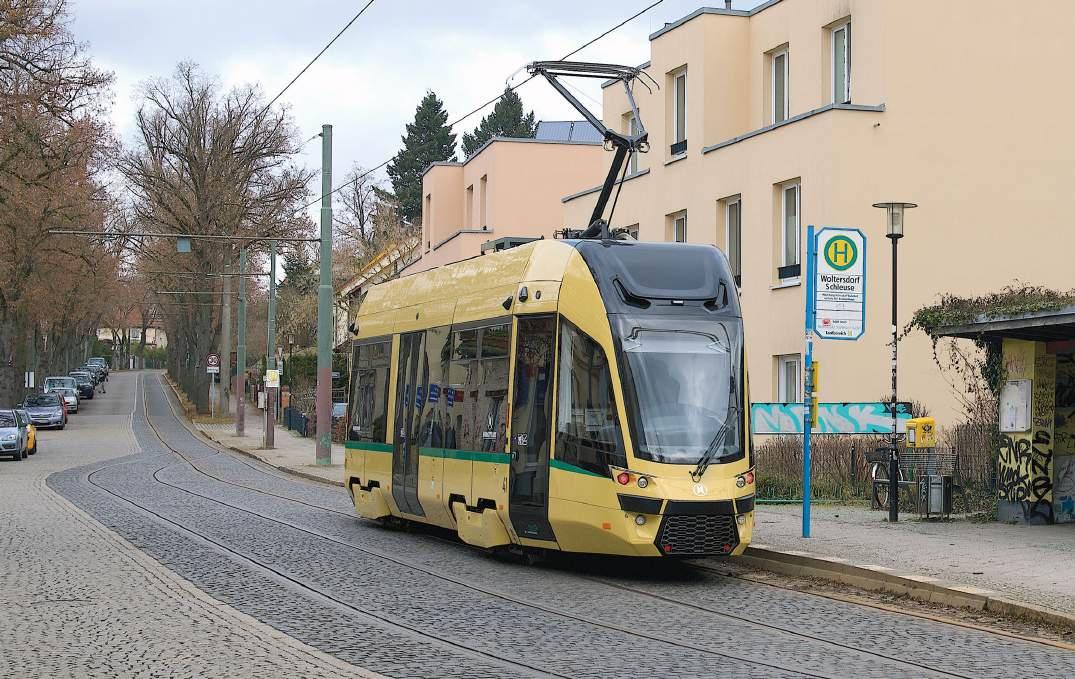
TAUT reports on Woltersdorf, where Moderus Gamma cars have now been in service for six months.
Is no news good news, to use the old cliché? Sometimes yes, if that means things are working as they should.
Now, six months after Germany’s Woltersdorfer Strassenbahn introduced new bogie vehicles – the first such in the 5.6km (3.5-mile) line’s more than a century of history, the news is… that the Moderus Gamma cars have been running reliably.
Other than occasional forays to cover, the old Gotha T57 trams that for many years made this tramway a real rarity and known around the world among tramway enthusiasts, have stayed on the depot. The exceptions have mainly been at peak times.
It means that this charming standardgauge line on the outskirts of Berlin, which runs through Brandenburg and opened in 1913, has finally joined the low-floor era.
Getting to this point was a long story. Until recent months, what’s known in timetables as Berlin’s route 87 had only used four-wheeled cars, most recently the Gothawagen. Dating from the late 1950s and early 1960s, and active at Woltersdorf since the 1970s, these traditional vehicles with their steps into the passenger compartment are not compliant with modern disabled regulations on barrier-free entry.
A tender for new vehicles was launched in 2021, and in 2022 it was announced that Poland’s Modertrans had won a contract for
three Moderus Gamma LF 10 AC BD
The order was later increased to four through the exercise of an option.
An initial delivery took place during March 2024, and all four cars (41-44) were in Woltersdorf by January this year. Then on 25 January came their long-awaited entry into service.
That was successful enough that the tramway was able to hold a major celebration marking the close of the Gotha era on 1 March (TAUT 1050).
Since then, 1959-built T57 28 has been transferred to the Hannoversche Straßenbahn-Museum in Sehnde, Lower Saxony. Meanwhile 29 (1961) and 33 (1957) are now part of Woltersdorf’s heritage fleet, which also includes gems such as 1913-built motor car 2 and trailer 24.
It means that early-morning commuters from Woltersdorf into Berlin, and daytrippers to the popular leisure spots on the lake around Woltersdorf Schleuse, no longer have the historic charm of riding in a reminder of the classic tramway era. They do, however, have the comfort of modern, low-floor cars.
In choosing the Moderus Gamma, Woltersdorf has selected vehicles from a successful low-floor family that now has nearly a decade of heritage behind it. The five-section single-ended prototype (designated LF 01 AC ) was trialled on
ABOVE: The Moderus Gamma trams have been running reliably since January, marking Woltersdorf’s successful integration into the modern tram era. Images courtesy of Tony Streeter unless stated.
Modertrans’ Poznan ‘home’ system and also that of Gdansk in 2017.
Since then the type has had success in various Polish cities – Łód ź, Poznan, Szczecin and Wrocław – but the version for Woltersdorf has perhaps more in common with another prototype, the LF 05 AC Completed in 2021, this single-ended car is formed of a single section.
The Woltersdorf cars are, however, bi-directional, as required on the Brandenburg line. Although it has a triangle at Thälmannplatz (part way along its route, and adjacent to the depot), it has no balloon loops; cars simply reverse at the end of the termini.
Nor are Woltersdorf’s cars the end of the Moderus Gamma story: a contract for four of the type (later raised to 12 through the exercise of an option) was signed with Poland’s Szczecin last December. The 32m three-section vehicles are expected to be delivered to the Baltic coast city in 2026.
The Moderus Gammas may be the first lowfloor cars at Woltersdorf, but they are also the first brand-new vehicles of any sort in decades. Indeed the T57 motor cars (and B57 trailers) that the tramway became known for came here secondhand from other systems; the first Gothawagen arrived in 1978.
Before that, Woltersdorf had run a motley vehicle collection, including hand-me-downs from both nearby Berlin and elsewhere.
New trams had been provided for the line’s opening in 1913 – four motor cars (1-4) and six trailers (21-26) from Orenstein & Koppel. In 1925-26 a Cristoph & Unmack car (5) joined the fleet, then during World War Two Woltersdorf received both a secondhand car from Salzburg and the prototype Kriegsstrassenbahnwagen (KSW) austerity car (7) after the latter’s trials in Berlin.
Further secondhand vehicles followed in the postwar years, notably six Berlin TF 13/25 cars in 1962 (which were the same age as Woltersdorf’s original trams), and six KSW trailers from Magdeburg and Strausberg in 1968-69.
Real change came with the opportunity brought about by other systems’ introduction of Tatra bogie cars. In 1977 an ex-Schwerin ‘Reko’ trailer entered service – but then the first two ex-Schwerin T57s and one B57 arrived the year after that. A pair of T57s arrived from Dessau in 1978 too.
So started the beginning of the Gotha era, with acquisitions gradually taking place over decades; car 33 (ex-Dresden) was taken on from Dresden in 2008, and only entered service in 2018.
The disappearance of Gothawagen from regular use at Woltersdorf truly marked the end of an era – though aficionados can still ride in such classic vehicles at Naumburg and Bad Schandau (Kirnitzschtalbahn).
Whether the new cars will gain such a following as those they have replaced, or be in use well after their 60th birthdays, will be a story that only time can tell.
RIGHT/
BELOW RIGHT:
The new Woltersdorf cars are bi-directional. They are also, most importantly, finally compliant with modern disability regulations and offer passengers barrier-free entry, which was lacking in the older fleet.
Top image courtesy of Modertrans.

and
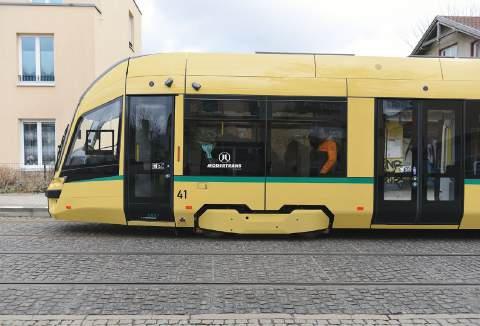

“The Moderus Gammas may be the first low-floor cars at Woltersdorf, but they are also the first brand-new vehicles of any sort in decades.”
Listening to safety concerns can highlight unknown risks or unsafe situations.
Your drivers, station staff and engineers identify issues as they happen, using knowledge and experience to help you understand what’s going on. You welcome concerns from your frontline and invite them to tell you what they know.
But people aren’t always straightforward. Even with the best safety systems, in the most open safety cultures, not everyone reports concerns openly.
As a member of CIRAS confidential safety hotline – as most UK light rail networks are – you have a safety net alongside your other reporting channels. At CIRAS, we listen to the concerns you might otherwise miss. Offering a confidential option can help close the reporting gap.
By letting your staff know a confidential safety hotline is available, you’re showing that you want to hear from them, however they speak up. What matters is that you’re listening. When people know someone’s listening, they make the right call and report their concerns.
We listen carefully and impartially to every concern, and we make sure reporters get a

response, so they know they’ve been listened to. We’re your partner in building a listening culture where everyone can be heard.
To help you raise awareness of the CIRAS confidential safety hotline, we offer a range of resources. These are in the member resources area of our website. Or, ask your CIRAS stakeholder manager. You can order merchandise including posters, flyers, coasters, and more, from our online shop (details on our website).
Registering to our website with your e-mail address allows access to all our reports. You’ll find shared good practice from light rail and across transport, videos and webinars, plus useful guides on how to promote CIRAS and how to respond if you receive a CIRAS report.
Find out more at:
https://www.ciras.org.uk/rightcall. Not sure if your company is a member? See the members list on our website.
Thousands of organisations in the transport sector are members of CIRAS. We build a strong listening partnership with our members to improve safety. Our confidential safety hotline provides extra listening to help staff make the right call and report their concerns even when they feel they can’t use other channels. When we listen, we learn.
Learn how you can build your listening partnership with CIRAS at ciras.org.uk/rightcall.

Scan me
We find safety in listening.
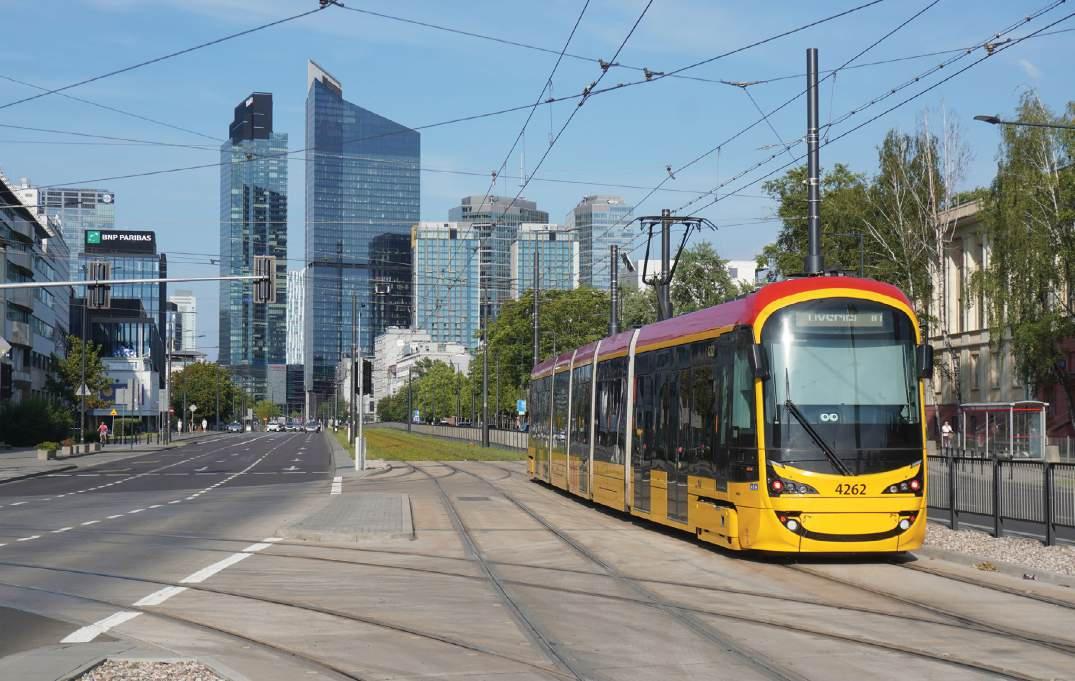
Andrew Thompson recounts a continuous history of growth and expansion in Poland’s capital city, and looks at where plans will lead in the future.
With a population of roughly 1.86 million in the city and 3.3 million in the greater conurbation, the Polish capital of Warsaw (Warszawa) is by far the largest city in this nation of roughly 38 million. Incidentally, Warsaw does not boast Poland’s largest tram network, as that distinction goes to the expansive interurban system in the Upper Silesian coal mining basin centred on Katowice. Nevertheless, the Warsaw light rail network does span an impressive 133km (82.6 miles), and will continue to grow during the coming decade. Since 2013, the capital’s tramway has been extended nine times, with four of those extensions happening since March 2024. Most recently the 800m-long branch to Stegny opened in late June 2025, capping the impressive Wilanów project in the south of the city.
Warsaw’s first horse trams date back to 1866, when Poland did not exist as an independent nation state – since the late 18th Century it had been divided into Prussian, Russian and Austrian territories. Warsaw was in the Russian-controlled area and correspondingly suffered from slower industrialisation and lagging economic development compared to other cities in central and western Europe, even though
‘Congress Poland’ was actually one of the more progressive areas in the Russian Empire during the mid-19th Century.
The dubious management of Polish affairs by the Tsar’s local administrators resulted in armed, violent uprisings against Russian rule in both 1830 and 1863, which ultimately proved unsuccessful in shaking off the overlords and only led to an intensified policy of forced Russification and suppression of Polish identity. It would not be until after the conclusion of World War One that Poland would regain full independence.
Warsaw’s first horse tramway was built in spite of resistance from Russian officials, as Belgian investors initially paved the way. The first line connected the city’s original two railway stations, one located on each bank of the River Vistula (Wisła). On the western bank was Dworzec Wiede ń ski with the main line south to Vienna (Wien), on the east bank in the Praga district was Dworzec Petersburski with the link to Vilnius and St. Petersburg.
In 1900 the broad-gauge tram network was taken over by the municipality and gradually electrified from 1903-08. The real boom then took place after Polish independence in the 1920s, when tram lines started to reach the extremities of the city. After serious infrastructure and
ABOVE: In early March 2024, the new 1.8km (1.1-mile) direct link between Szpital Wolski and Reduta Wolska was opened. This east-west alignment connects the Warszawa Wola railway station with the tram network and serves two new stops. On 13 July 2024, the double-ended Hyundai 4262 is seen at the Szpital Wolski junction while running inbound with a line 11 service.
vehicle losses during World War Two, the tramway was rebuilt and converted to 1435mm standard-gauge after 1945, experiencing further growth as new routes were required to serve peripheral housing estates. Another building boom took place after the fall of the Iron Curtain in the 1990s, with new lines being built in the west of the city to destinations such as Cmentarz Wolski and Nowe Bemowo.
A number of important tram projects have also been implemented during the past 12 years, including the fourth light rail crossing of the River Vistula in the north of the city with the major northern expansion of line 2 from Zajezdnia Ż oliborz across the river to Stare Świdry. This branch was then successively extended in stages, beginning in December 2014 to Tarchomin Kościelny, in February 2017 to Nowodwory, and finally in September 2017 to Winnica.
In this decade, the 2.5km (1.6-mile) link between Szpital Wolski and Reduta Wolska was opened in March 2024, creating a new, faster through line in the west of the city and eliminating a circuitous detour.
Even larger in scale and significance is the new spur to Miasteczko Wilanów in the south, which includes an 8km (five-mile) trunk route and two diverging branches with respective lengths of 800m and 1000m, serving areas of the city previously only connected by bus.
The whole scheme had a budget of around EUR275m, of which roughly EUR127m was covered by EU grants. The first part of the new southern extension, running for 2.1km (1.3 miles) from Goworka to Sielce, opened in May 2024. This was followed in October 2024 by the longer 6.8km (4.2-mile) trunk route from Spacerowa junction to Miasteczko Wilanów. The short Stegny opening in June 2025 marked the completion of the largest addition to the Warsaw tram network in the 21st Century to date.
The next crucial project is the link to Warszawa Zachodnia station, which is the first part of a larger orbital route in the west of the city, designed to connect the Ochota and Wola districts with more direct routes than currently exist. Construction on the 1.6km (one-mile) first leg from the Bitwy Warszawskiej 1920 junction is already underway. It will initially take tram tracks to Zachodnia, coming from Ochota to the south. The second stage, with the northern continuation of the tram tunnel to Wola and eventual branchoff with two separate branches, is pending

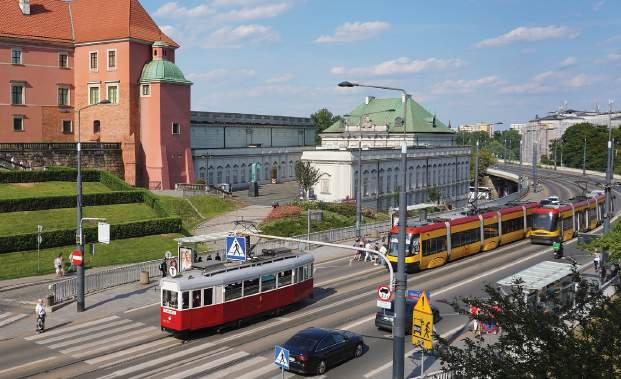
ABOVE: Dedicated tourist lines using vintage stock are a fixed offer in Warsaw. Lines T and 36 operate with classic cars at weekends and on public holidays during the summer. Pictured is tram 4031 dating from 1940. It first ran in Berlin during World War Two and came to Warsaw in 1946. The vehicle showcases the earlier red and white livery as it departs from the Old Town stop Stare Miasto, with the Royal Castle in the background.
“The next crucial project is the link to Warszawa Zachodnia station, the first part of a larger orbital route in the west of the city.”


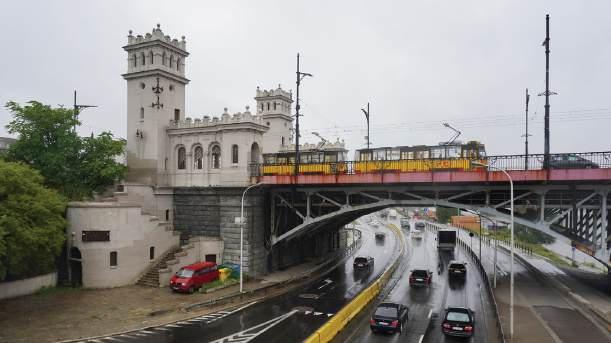
LEFT: The Polish capital features a dynamic skyline and a plethora of modern office towers, including the 220m-high Warsaw Spire, which frames one of the light rail trunk routes through the business district as a double-ended Jazz Duo LRV passes the major tram and metro interchange at Rondo Daszyńskiego. Fifty of these low-floor cars were supplied by PESA in 2014-15.
BELOW LEFT: Until the next major tram tender for up to 160 new cars is completed, the older high-floor cars will remain in use in Warsaw, even though several Konstal 105Na have already been withdrawn or cascaded to Konotop in Ukraine. Here, such a high-floor tandem is seen passing over the landmark Most Poniatowskiego. Originally built in 1904-14, the turreted bridge is one of four tram crossings over the River Vistula in Warsaw and the most architecturally celebrated. Destroyed in both world wars, the bridge is a symbol of the city's resilience.
finance and is not expected to be completed before 2032.
As the tram network has grown over the past three decades, the Tramwaje Warszawskie (TW) rolling stock has also kept pace with the times. The city’s first barrier-free, partial low-floor tram was introduced in 1995 with the Konstal 112N prototype. From 1998-2000, a series of 29 very similar type 116N were delivered and continue to run on major lines around the city. In 2007, domestic producer PESA won an initial contract for 15 fully low-floor, five-section Tramicus LRVs. Warsaw placed five more major fleet orders with PESA over the next decade, procuring 180 unidirectional Swing in 2010, six bi-directional Swing Duo in 2012, 50 bi-directional 128N Jazz in 2015, and 30 uni-directional short type, three-section 134N Jazz in 2015. PESA expected to win another major tram order from TW in 2019, but instead the contract for 125 LRVs in three different variants went to Hyundai Rotem, which completed delivery of the Korean-made vehicles in late 2023. Although Warsaw’s low-floor fleet therefore has strength in numbers and is several hundred units strong, the remaining high-floor Konstal trams still remain indispensable. The operator is therefore preparing to purchase another 20 trams with options for up to 160 new LRVs in total. After initial consultations, only Škoda and Hyundai are in the running for the contract.
As the other backbone of rapid transit, Warsaw’s metro network continues to be continuously expanded. Incidentally, it is also the only metro system in all of Poland. Compared to other European cities, Warsaw’s metro is relatively young, and a first 11.5km (7.1-mile) north-south section of M1 opened in April 1995 between Kabaty and Politechnika on the western bank of the river. By October 2008, eight further extensions of M1 had been implemented, increasing the full length between Młociny in the north and Kabaty in the south to 22.6km (14 miles) and a total of 21 stations.
In March 2015, M1 was supplemented with M2, which runs from east to west and also crosses under the Vistula between the Centrum Nauki Kopernik and Stadion Narodowy stops. The first section of M2 was 6.1km (3.8 miles) long and included seven stations. In September 2019, M2 was extended at its eastern end by 3.1km (1.9 miles) from Dworzec Wile ń ski to Trocka, and in April 2020
at its western end by 3.4km (2.1 miles) from Rondo Daszy ń skiego to Księ cia Janusza. The next expansion took place in June 2022 at the western end with two stops and a 2.1km (1.3-mile) route from Księ cia Janusza to Bemowo. In late September 2022, the eastern section of M2 from Trocka to Bródno was also extended, adding three more stations and 3.1km (1.9 miles) of route. The line is not yet complete, however, as to the west construction work is currently underway for the next 4km (2.5-mile) extension with four more stations to Karolin. Inauguration of this next phase of M2 is scheduled by 2026.
Between Bródno in the east and Bemowo in the west, M2 is currently 18.6km (11.6 miles) long. Since its opening in 2015, M2 has been operated by a total of 20 sixcar Inspiro trains, which the consortium of Siemens and Newag delivered in 2013-14. A total of 15 of these Inspiro trains run on M1. However, because this existing fleet is not sufficient for the eventual length of M2, the operating company Metro Warszawskie ordered a total of 37 six-car Varsovia trains from Škoda in 2019. The prototype was delivered to the Polish capital in April 2022. From late autumn 2022, the first of these 119m-long trains were deployed on both M1 and M2. By late 2023, the entire series was in service.
In contrast on M1, the last of the originally supplied, Russian-built Class 81 metro trains were withdrawn in March 2023. A number of these heavy, energy-inefficient Soviet sets were then gifted to the Ukrainian capital Kyiv in April 2023, some for continued deployment, others as spare part donors. In addition to the modern Inspiro and Varsovia cars, Metro Warszawskie also has 18 Alstom Metropolis trains, which were produced in Barcelona and Chorzów from 2000-05 and are deployed on line M1.
The Warsaw metro network will not remain limited to two lines, as the construction of M3 was approved in spring 2021. This eastern link is planned to run from the M2 junction at Stadion Narodowy to the eastern main line station Warszawa Wschodnia, before splitting into two branches. One short branch will run further east to STP Kozia Górka, while the slightly longer branch will turn south and run via Rondo Wiatraczna to Gocław, serving a densely-populated area of the city currently only reached by trams or buses. These initial two M3 routes will be 9km (6.5 miles) long, and according to current plans could open by 2032.
In the longer run, M3 is to be taken further south from Gocław and lead westward under the river to link up with M1 at Racławicka, before terminating at Żwirki i Wigury in close proximity to Chopin Airport. For the year 2050 and beyond, city officials even have a master plan with a total of five metro lines, although this concept is only on the drawing board.
RIGHT: Starting in 2022, Škoda delivered a total of 37 type Varsovia metro trains to Warsaw. Here car 78 is seen on 3 January 2023 at Księcia Janusza. This was the western terminus of the Warsaw Metro line M2 from April 2020 to June 2022. Since then, the M2 route has been extended by 2.1km (1.3 miles) and two stations have been added.

RIGHT: Hyundai Rotem 4250 runs on the grass tracks of the new major trunk route southbound to Miasteczko Wilanów, shortly before reaching Św. Bonifacego on 9 August. This important extension in the south of the city opened in October 2024 and is served by lines 14, 16 and 19. The Korean-built cars were originally supposed to be branded as ‘Warsolino’, but the moniker never caught on and staff have instead given them the nickname ‘Hultaj’ (varmint).
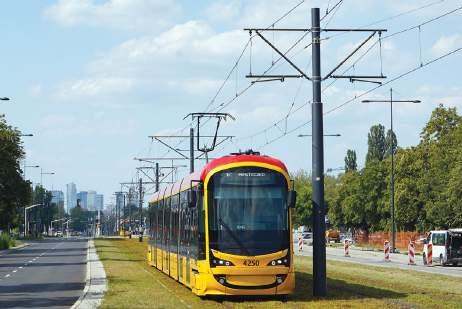
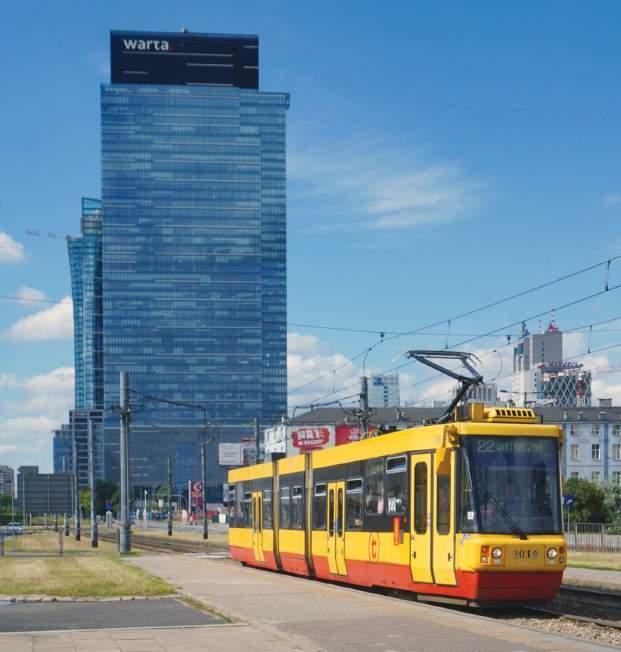
“Although Warsaw’s low-floor fleet has strength in numbers and is several hundred units strong, the remaining Konstal trams remain indispensable.”
Tiny by comparison with the metro system for which it is a feeder, the Shenzhen tramway launched as a ‘Demonstration Line Project’ provides local coverage in varied surroundings.

From a western perspective, Shenzhen was almost defined in the past by being where China bordered the then-colonial territory of Hong Kong. It grew from a riverside settlement previously known as Shum Chun which in 1911 became the border crossing of the KowloonCanton Railway. Shenzhen in Guangdong province has now greatly exceeded Hong Kong’s population and area. Designated a city in 1979 with a population of around 30 000, Shenzhen reached a million by the turn of the century. At the end of 2024, the Shenzhen Government Office identified a permanent resident population of almost 18 million.
The metropolitan area now extends beyond the city borders and into other municipal jurisdictions. Far from being regularly-shaped, nor a continuous urban sprawl, in places Shenzhen is 66km (40 miles) east-west and 40km (25 miles) north-south. For context, Hong Kong Island’s maximum is a diagonal and mainly rural 16km (ten miles). Shenzhen is about 100km (62 miles) south-east of the Guangdong capital, Guangzhou, with both being part of the Greater Bay Area plan for developments around the Pearl River estuary.
Shenzhen established its own identity by becoming a technologybased manufacturing and research centre on an epic scale. It also rapidly
ABOVE: SZ Tram 111 in the official system livery near HTIP East on 22 April 2025. When the service changed from three to two lines soon after opening, this eastern branch became served directly only from the south.
created support infrastructure like ground transport, port facilities, an international airport and financial services. Such changes were triggered in 1980 when some districts were designated as a Special Economic Zone (SEZ), a status extended to all Shenzhen districts by 2010. This gave tax advantages to investors and reduced the level of permissions needed for commercial development, including for non-Chinese companies. Marked by a cluster of high-rise buildings, the south-central Futian district has the biggest concentration of business and administrative premises. Telecommunications giant Huawei and the BYD group, best known for its electric vehicle range,

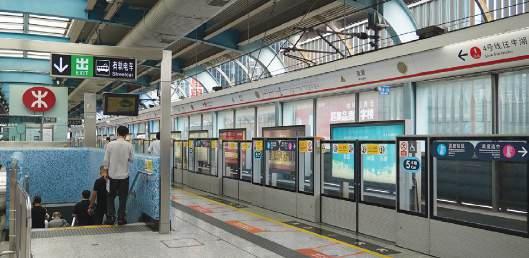
All services are run by 15 bi-directional, low-floor trams used as single units. They include Siemens electrical equipment and the bogie type as used in the Siemens Super Combino Trams LH101-115 were built in 2017 by the CRRC Zhuzhou Electric Locomotive Company. They have four sections, are 36 metres long and 2.65 metres wide. The fleet numbering extends whereby each section is numbered, for example LH110 consists of 1101, 1102, 1103 and 1104. The capacity for about 300 passengers includes good circulating space and a mixed configuration of hard plastic seating for about 60. There is stepped access to some unusually high inward-facing seats above the wheelsets. Fare validation is through on-board readers. Screens, signage and audio (including English) provide a high level of on-board information, with all services carrying a staff member – smartly uniformed, as are the drivers – to check tickets and provide assistance as needed. The system livery is mainly gold with white and black banding; there is also a range of promotional finishes including public information.
ABOVE LEFT: Xinlan terminus added the tram system’s second metro connection at nearby Gualan station when the line 4 extension opened in October 2020.
LEFT: Features at the elevated Qinghu metro station reflect line 4’s operation by Hong Kong’s MTR Corporation. Terms ‘streetcar’ (as here) and ‘tramcar’ are both used on the system’s signs.
BELOW: The distinctly urban site of the initial metro line 4 interchange at Qinghu: most of the system has more spacious surroundings, albeit including sections between busy roads.
“It was as a metro-related scheme that construction formally started during June 2015.”
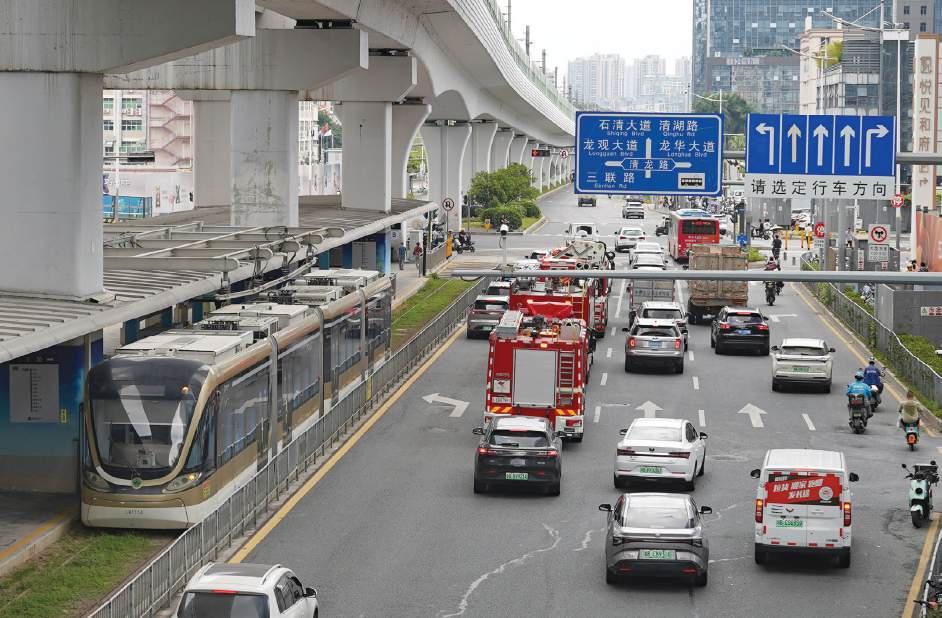
were founded in Shenzhen. The northern Longhua district became the main production site for the world’s biggest electronics manufacturer, Taiwan-based Hon Hai Technology Group (Foxconn). Increasing the size of Shenzhen’s workforce was enabled by mass domestic migration, a factor in the predominance of Mandarin in an historically Cantonese-speaking area. This can explain variations in English renderings drawn from the two versions of language.
Although Shenzhen has a capacious motorway and local road network, since the first two metro lines opened in December 2004, it has created a near-600km (375-mile) system. This is at its densest across the southern districts. From Futian, the 31km (19.4-mile) metro line 4 – the first of two now operated by a Shenzhen subsidiary of Hong Kong’s MTR Corporation – extends north through
Opened: 2017
Lines: 2
Depots: 1
Approx. weekday hours: 06.30-23.00
Line frequency: 10-15 minutes
Gauge: 1435mm
Power: 750V dc, overhead supply at stops for recharging Fleet: 15
City network/operator: SZ Tram
Shenzhen Metro – English version: https://www.szmc.net/szmc_en
Civic and tourist information: www.sz.gov.cn
the Longhua district. It was as a metrorelated scheme that construction formally started during June 2015 on the ‘Longhua New Area Tramway Demonstration Line Project’. This was delivered jointly under a BuildOperate-Transfer contract by two state-owned bodies, the Shenzhen Metro Group founded in 1998 and the China Railway Construction Investment Group. The SEZ districts have strong identities and specific features, as exemplified by the Longhua administration’s www.
szlhq.gov.cn. A 2024-dated news release continues to represent the tram service as a ‘demonstration line’. Following trial operations, full services branded as SZ Tram began in October 2017. The coverage includes proximity to several major business parks, plus residential and retail areas. Although the metro has a long reach, distances between the lines towards the network’s edge are appreciable. As such, the trams were presented as a metro feeder and an alternative to buses, private cars or (very prominent in Shenzhen) electric scooters.
From the outset SZ Tram had a metro line 4 interchange at Qinghu, where the southern terminus is sited under the metro viaduct which stretches along a main road. Both faces of the Qinghu island platform are used for arrivals and departures, with trams almost immediately turning onto another road where crossovers enable the system’s right-hand running.

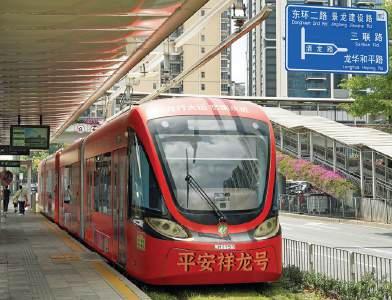
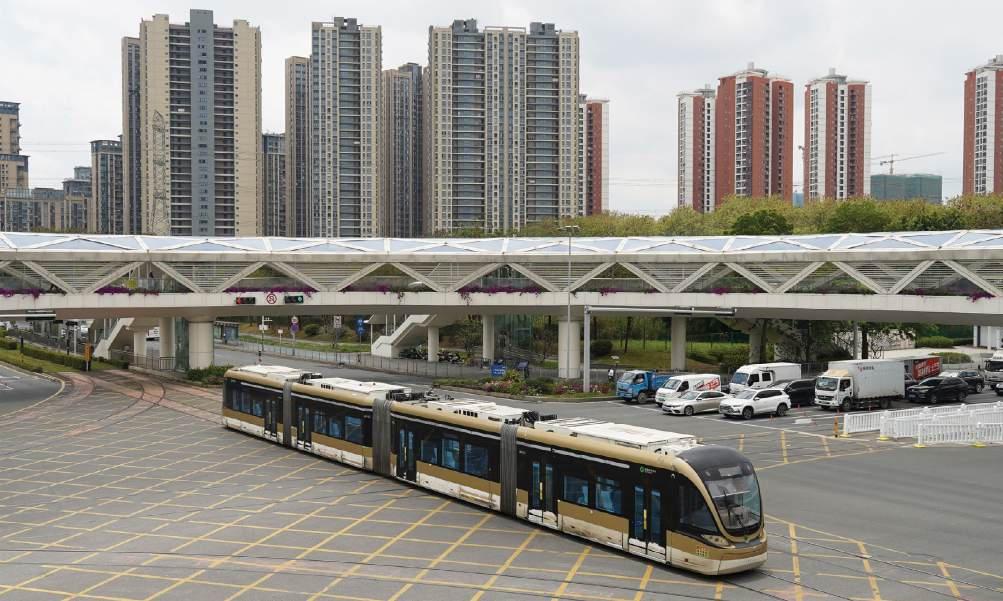
Much less dominated by its surroundings, the northern terminus of Xinlan has similar platform arrangements. Xinlan became the second of the tramway’s two metro interchanges when the nearby deep-level Guanlan station opened with line 4’s northern extension in October 2020.
Based on early ridership, a threeline tram service was soon reduced to two. Line 1 runs 9.2km (5.8 miles) between Qinghu and Xinlan; it is very much the busier of the two. Line 2 runs between Qinghu and Xiawe, leaving the route shared with line 1 at Dahe to take the eastern branch. Bounded by a mix of completed and in-development buildings, this branch extends about 3.1km (1.9 miles) from Dahe. Xiawei terminus has staggered separate arrival and departure platforms, beyond which is a short turn-back. Dahe has side platforms which are dispersed around a very wide road intersection. Above this is a walkway circuit which integrates tramway access with being a general crossing. With the short-lived direct north-to-east service deleted, such journeys can be made with a change at Dahe, although the distance between platforms is considerable. As further south near the Qinglong stop, a track stub at Dahe extends from a junction, installations seemingly anticipating expansion as referenced in reports around the tram service’s launch.

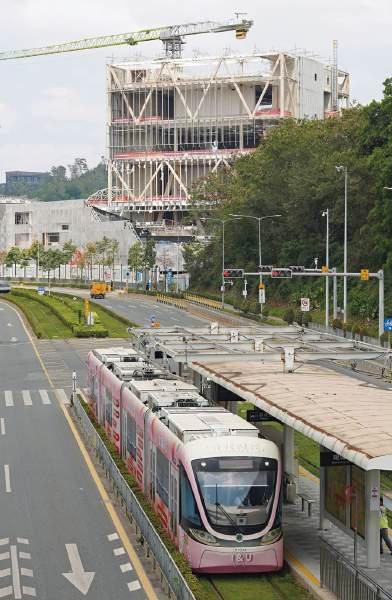
LEFT: The northern arm has some open areas and sites under redevelopment: 103 recharges at Guancheng.
RIGHT: Not standard across the system, these platform-edge railings have gaps to align with tram doors at Dahe. The conductor rail is integral with the structure at stops.


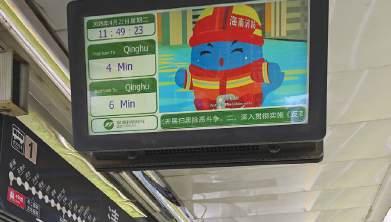
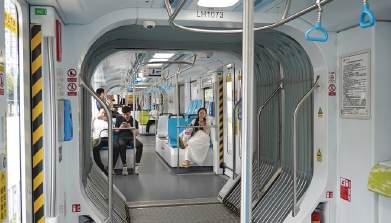
The system’s revenue route is entirely wire-free, with trams fitted with super-capacitors which are recharged at every stop. A pickup on a permanently raised small frame makes contact with a conductor rail which is integrated with the platform canopy structure. Charging for 20 seconds during the normal dwell time provides ample power for the distances between stops: the longest such distance is the 0.9km (0.56 miles) between Bilan and Meilong. The 20 stops are signed as stations, these variously with island or side platforms, with some staggered around traffic intersections.
Security checks are standard in China for access to railway stations, including metro, although this does not extend to Shenzhen’s tram stops.
The stops are amply sheltered, a sensible feature in a region where rainfall can be sudden and torrential. Most of the track has dedicated space, much with grass surrounds and floral beds which bring a welcome contrast to some wide and austere roadways. All tram platforms have level access, either by lift from walkways or at light-controlled street crossings.
North of Dahe are some comparatively undeveloped areas, beyond which is the depot site between Hexi and Guancheng
stops. With a network run through franchised operators, buses are second to the metro as the main specifically urban mode. Part of the public transport network in eastern Shenzhen, Pingshan Sky Shuttle uses BYD’s proprietary battery-powered system on an elevated 8.5km (5.3mile) route between BYD North Station and the Shenzhen Pingshan high-speed line station.
Shenzhen (as opposed to China in general) has specific arrangements for cross-border visitors, now including the five-day ‘Special Economic Zone Tourism Visa On Arrival’ (single entry only – cannot be used for successive day trips). Note that entry requirements and the fees payable may vary according to the passport held: such formalities should be checked in advance of travel. To minimise waiting, it is recommended to research when border facilities are likely to be heavily used – notably around public holidays. Main internet information sources based outside China are blocked, but online local navigation should be possible with a Chinese app such as Amap (www.amap.com). Although general interest in public transport and photography of working lines seems accepted, any depot, storage or maintenance facility should be treated as a sensitive area.
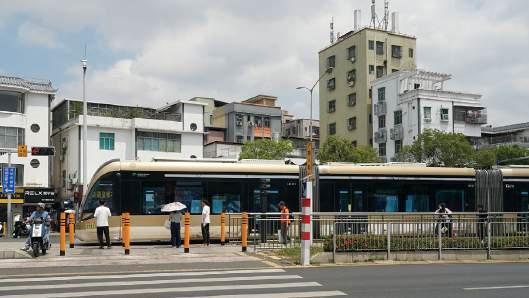

ABOVE: Surroundings at the stop signed as Century Square Station (diagram as Century Pl.) have a more local neighbourhood atmosphere than on most of the system.
LEFT: A southbound line 1 service at Dahe: the generous amount of platform shelter is a system feature.
Local travel: If entering Shenzhen via Hong Kong, two MTR East Rail Line termini adjoin border crossings where passengers disembark to pass through the formalities on foot. These are Lo Wu to Luohu (for Shenzhen metro line 1) and Lok Ma Chau to Futian Checkpoint, from where metro line 4 gives the most convenient access to SZ Tram. A road crossing with shuttle buses links Hong Kong’s Lok Ma Chau (San Tin) public transport interchange and Huanggang Checkpoint (Shenzhen metro line 7). The High Speed Rail service (www.highspeed.mtr.com. hk) connects Hong Kong West Kowloon and Shenzhen Futian stations. SZ Tram ticket machines include instructions in English and give applicable fares: if not using a pass, having low-value Renminbi/Yuan notes or coins is useful: RMB/CNY10 approximates to GBP1.00. The anonymous-format ‘OctopusChina T-Union Card’ can be bought in Hong Kong which allows for loaded value being used for urban public transport in Shenzhen and many other Chinese cities (www.octopus.com. hk). The Hu Tong Xing card is a counterpart sold in Shenzhen at metro service counters. All information as available September 2025.
What is there to see? For many western visitors, simply travelling around Shenzhen will hold inherent interest. The area is, however, a highly regarded destination for the substantial domestic tourist market. High speed lines with connections across China are centred on Shenzhen North station in Longhua: the mode has obviated other cross-border trains from Hong Kong. Although far from centrally-sited within in the city’s modern boundaries, Shenzhen Railway Station just north of the Lo Wu-Luohu crossing is important for regional and inter-city trains. A loud and colourful tourism and shopping area is nearby. Shenzhen’s road traffic at crossings is well ordered for pedestrians, but care is needed due to the profusion of electric cycle/scooters which seem little constrained in their movement. There are extensive rural and hilly areas interspersed with the urban spread, plus formal parklands, beach resorts and theme parks. A free open air railway museum is on the former Gong Ye Zhan /Industry site, a short walk over the main line beside metro line 3’s Caopu station.

LEFT: Unlike the other two termini, the comparatively little used Xiawei has separate arrival and departure platforms.
BUENOS AIRES. CRRC Changchun has been awarded a contract to supply 174 metro cars to replace existing stock on line B. The line’s voltage will be raised from 600V dc to 1500V dc. RGI MENDOZA. Banco Santander Argentina is to loan the provincial government ARS23bn (EUR14.7m) in order to extend the 17.6km (11-mile) light rail line. It will run north 4.8km (three miles) to El Plumerillo International Airport and south 15km (nine miles) to Luján de Cuyo, by 2027. IRJ
ADELAIDE. On 31 August, the Government of South Australia took over tramway operations from the Torrens Connect consortium. Keolis Downer is to maintain the fleet and infrastructure until 2035. Commuter rail services returned to government control in February 2025. dit.sa.gov.au GOLD COAST. G:link tram 11 was damaged on 13 September when it split the points at a crossover near Cavill Avenue and demolished an overhead mast. Normal service resumed on 14 September. abc.net, R. Tressteleg MELBOURNE. Alstom’s Dandenong factory delivered the first G-class 100% low-floor tram, 7002, to the new Maidstone depot on 12 September. Each 25m three-section tram accommodates 150 passengers (48 seated). They are due to enter service in the first quarter of 2026. M. Rowe
GRAZ. The city centre relief tramway between Roseggerhaus and Jakominipl is to open on 29 November. It will be used by new lines 16 and 17. The first trial run took place on 11 September.
Lines 1, 4, 6 and 7 resumed their normal routes on 8 September. urbanrail.net INNSBRUCK. The Stubaitalbahn’s bus replacement service ended on 14 September. It had been in use since 28 June to permit bridge replacement.
Line 6 was partly closed from 28 September to permit overhead renewals. It was due to resume service throughout in mid-October. BS WIEN (Vienna). Flexity 419 was delivered in September. The Alstom vehicles are now in use on line 43. Line 71 is the last to be fully operated by E2+c5 sets.
The line 27 extension to AspernNord is due to open in early October.
Fare increases are to be introduced on 1 January. A single ride changes from EUR2.40 to EUR3.20.
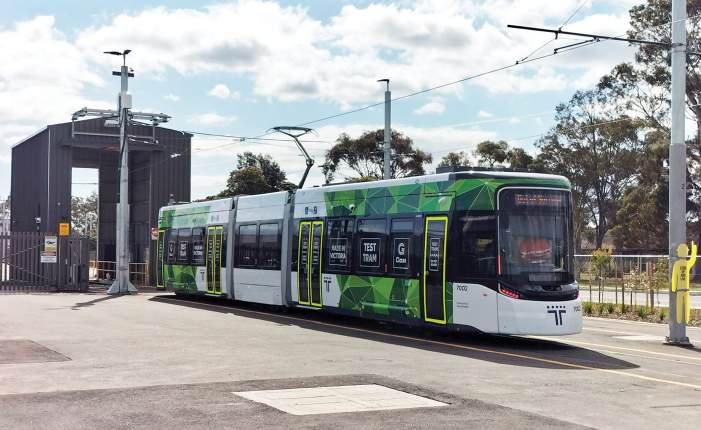
An annual ticket rises from EUR365 to EUR467. tramwayforum.at
BRUSSEL/BRUXELLES
(Brussels). Articulated PCC 7703, the oldest tram still in regular service, celebrated its 54th birthday on 14 September.
Line 82 returned to Chaussée de Neerstalle from 25 August for the first time since July 2022.
Tram services between Midi and Porte de Hal were suspended on 27-28 September to permit work on the metro conversion of the north-south subway to take place. The projected cost of the conversion and extension to Haren has risen from EUR2.3bn to EUR4.7bn and so Gare du Nord – Haren may not open until 2039. T-2000
COCHABAMBA. The 5.8km (3.6-mile) Yellow tram line was opened on 17 September. It links the Old Railway Station to Jorge Wilstermann International Airport and the new bus station. transphoto.org
OTTAWA. Full performance testing on the O-Train Stage 2 East light rail extension to Trim started on 13 September using 23 Alstom Citadis Spirit LRVs. Passenger services could start before the end of the year.
SANTIAGO. Construction of the 27km (17-mile) metro line 9 started at the site of La Pintana depot on 19 August. RGI
CHENGDU. Passenger services on the 24.8km (15.4-mile) metro line 17 (Jitouqiao – Gaohong) began on 17 September. The same day, line 10 was extended by 5.9km (3.7 miles) from Taipingyuan to Wuhou Shrine. urbanrail.net
JINAN. Trial operation started on metro line 4 on 31 August. skyscrapercity
NINGBO. The 39.4km (24.5-mile) metro line 7 (Yufan – Yunlong) opened on 29 August. There are interchanges with lines 1-5. Line 6 is to open in 2026. urbanrail.net
TIANSHUI. The tramway undertaking has paid scrap price for 12 AnsaldoBreda/CRRC trams and spare parts from the closed system in Zhuhai. BS
BRNO. Tenders have been invited for the construction of a tramway in the boulevard connecting to the new railway station at Trnitá. TP OLOMOUC. Tram 203 became the last Škoda 03T Astra to be withdrawn on 27 September. cs-dopravak
OSTRAVA. A CZK37m (EUR1.5m) contract has been signed with Bosch Engineering to retrofit a collision-avoidance system to 77 trams by September 2027.
PRAHA (Prague). Line 16 introduced a daily Sídliště Řepy –Hostivař service from 1 September. Homologation of new Škoda 52T 9503 is proceeding. It had run 20 398km (12 674 miles) in passenger service by 3 September. Some software modifications are required; driver training is proceeding from Hloubětín depot.
The tender for a contract to add air-conditioning to 123 Škoda 15T trams has been cancelled.
Low-floor trams operated a special XB service between Florenc and Vysočanská while the Yellow metro line was closed in August. cs-dopravak, dopravak.eu
AL-Q Ā HIRAH (Cairo). CAF has been awarded contracts worth EUR450m to modernise 39 Line 2 trains and maintain them – along with 23 Line 1 trains – for ten years. IRJ
TALLINN. A tender has been issued for ten more low-floor trams, with the option for an additional 12. Delivery is required in 2028-29. TP
BESANÇON. New Alstom trams were due to enter service on 3 November lineoz.net
PARIS. Siemens has been awarded the contract to introduce automatic train operation on metro line 13. It is to equip the 66 new MF19 trains that are to be delivered in 2027-32. There is an option for 30 years of maintenance.
LYON. The public inquiry for the TEOL light rail line from Hôtel de Région Montrochet to ALA, including a 2.7km (1.7-mile) tunnel, was completed on 8 October. lineoz.net
NICE. Alstom is delivering 13 centre sections to enlarge the 2007-built Citadis trams not altered in a 2012 extension programme. Eight are to be in service by the end of November. T-2000


STRASBOURG. Test running on the extension to Wolfisheim started on 15 September. Passenger services are to begin on 15 November. lineoz.net
BERLIN. Trams resumed operation from Alexanderplatz to Hackescher Markt from 25 August after grassed tracks were installed.
The bridge under the railway at Köpenick Bahnhofstrasse was closed from 18 August, pending replacement. This is to affect tram services in Köpenick for some months.
Mohrenstrasse U-Bahn station was renamed Anton-WilhelmArno-Strasse on 23 August.
The first U-Bahn Type JK train started work on line 2 on 8 September; 484 cars are on order. A Deutsche Bahn/Stadler/Siemens consortium has reportedly won the EUR15bn contract to run the S-Bahn for 15 years. Delivery of 1380 new cars is included. Some news outlets have reported that Alstom might challenge the decision. Rbb24.de
BIELEFELD . The long-planned 1.3km (0.8-mile) line 4 extension beyond Lohmannshof has been approved. It is due for completion in 2028. DS BONN. Škoda had delivered trams 2251-53, 2351-59 and 2451-56 by mid-August. Just 15 R1.1 trams remain available for service. BS BRAUNSCHWEIG. Consultation is underway for a 3.5km (2.2mile) extension of line 4 from Krematorium to Rautheim. BSAG hopes to start work in 2028. BS BREMEN. Load tests using six trams took place on the Bürgermeister-Smidt bridge on 31 August. It is hoped that a resumption of tram traffic across the bridge can be approved. BS DRESDEN. Lines 4 and 9 have switched their eastern outer termini: Line 4 now runs to Prohlis and line 9 to Tolkewitz. BS DUISBURG. At the end of August just three Alstom Flexity
trams (2033-35) had yet to be delivered. Only 15 ten-axle GT10NC-DU cars were still in use (1001/07/13/15/18/26-8/33/34/4042/44-45). BS
DÜSSELDORF. The contract for the modernisation of 15 NF6 trams has been awarded to a Polish company.
GERA. Finance has been released to fund the purchase of three more Stadler TINA trams, to join the six already on order.
Six ex-Darmstadt low-floor trailers have been introduced on line 1, the first trailer operation since 1990. Former Darmstadt ST14 articulated tram 0775 is now Gera 213. TP, DS GOTHA. The last of the six ex-Basel trams, 206, entered service on 12 September. DS HALLE. The first of 17 45m Stadler TINA trams entered line 3 service on 2 September.
Local people have voiced information announcements for 50 tram stops to ensure that information is delivered with the correct accent. DS, BS KARLSRUHE. Talbot Services has rented a warehouse in Rheinhafen in order to refurbish and carry out corrosion treatment on 14 GT6-70 and six GT8-70 trams. The first to be dealt with are 222/223/231. BS KÖLN (Cologne). Talbot Services has won a EUR48m contract to carry out life-extension work on K4000 low-floor trams.
All cash ticket machines are to be removed from trams and buses and replaced by card readers for cashless payment. BS, DS MAGDEBURG. The realignment of 1.4km (0.9 miles) of tramway along August-Bebel-Damm is complete. The original alignment was put out of action during floods in 2013.
Flexity 1402, the first of the new 38m Alstom low-floor trams, entered service on 11 September. The line via Kölner Platz reopened on the same date, following completion of a temporary bridge at Damaschkeplatz.
Lines 1, 4 and 10 are running via Leipziger Platz and Wiener Strasse following another issue with a bridge.
High summer temperatures – up to 39oC in July – affected the motors of some older trams, resulting in service cancellations.
DS, BS MANNHEIM – HEIDELBERG (RNV). A EUR400m option for 34 more Škoda low-floor trams is being exercised. The Škoda trams already being delivered were used on Heidelberg local lines for the first time from 1 September. DS MÜNCHEN (Munich). Siemens continues to deliver new foursection Avenio trams, allowing the withdrawal and scrapping of nonmodernised R2 cars.
Lines 19 and 21 returned to their normal routes via Maximilianstrasse from 15 September.
Line 19 should start running through to Pasing again from 20 December, following completion of the new junction with future line 14.
A full-scale mock-up of a new Siemens S-Bahn coach was displayed on Königsplatz in September. The 90 200m trains are to start entering service in late 2028. Siemens NAUMBURG. Disagreement about subsidy will mean that the Deutschlandticket will no longer be accepted from 1 January.
Current financing from various sources is guaranteed until 31 December 2026. Services may have to be reduced in 2027. BS NORDRHEIN-WESTFALEN. The state government is making more than EUR1bn available to fund 13 local rail infrastructure renewals. This includes eight tramways. lok-report.de POTSDAM. Tram 442 became the second Stadler Tramlink to be delivered at the end of September. Passengers should be able to ride them in late autumn. BS SAARBRÜCKEN. Public transport was to be free on 2-4 October to mark the festival embracing the Tag der Deutschen Einheit (Day of German Unity). BS
WUPPERTAL . The restored Schwebebahn Kaiserwagen made its first test run in the early hours of 6 September. P. Bosbach
HUNGARY
BUDAPEST. Express tramline 37E was introduced while Keleti station was closed (25 August-20 September). It linked Magdolna utca and Kőbánya felső, stopping only at Hidegkuti Nándor stadium. Tenders have been issued for the reconstruction of the 10.7km (6.6-mile) HÉV line to Gödöll ő A tender for new LRVs will follow.
TP
DELHI. The Metro Pink Line was extended by 12.3km (7.6 miles) from Majlis Park to MaujpurBabarpur on 19 September. The 5.3km (3.3-mile) New Ashok Nagar to Saral Kale Khan extension opened the same day. urbanrail.net MUMBAI. Alstom has been awarded a contract to supply 39 six-car automated metro trains and Urbalis communicationsbased train control for the 35.4km (22-mile) Green Line 4. IRJ PATNA. The city’s first metro, the 5.4km (3.4-mile) Malahi Pakri – New ISBT Blue Line, opened on 23 September. The 1435mmgauge line is electrified using 25kV overhead. urbanrail.net
KARAJ. This municipality, west of Tehran, extended its Line 2 metro from Ayatallah Taleqani to Shahid Soltani on 6 September. urbanrail.net
DUBLIN. A fire damaged the Luas bridge over George’s Dock on 19 August. It was initially thought that Red Line services beyond George’s Dock to The Point would be suspended for a week. However, it is now expected that remedial work will last until November.
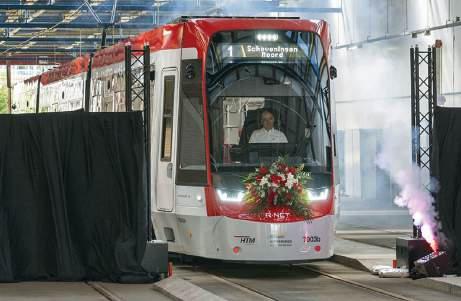
MANX ELECTRIC RAILWAY. Milne ‘Tunnel Car’ 6 is undergoing body overhaul. A metal frame was fixed to the body to enable it to be lifted from the chassis.
The Department for Environment, Food and Agriculture has added three MER viaducts to the Protected Buildings Register: Groudle and Laxey Glen Roy viaducts, and Ballure Bridge.
PALERMO. The city council has exercised an option for 14 more Urbos 3 trams in its contract with CAF. TR ROMA (Rome). Tenders have been invited for the reconstruction of the 950mm-gauge Termini –Giardinetti tramline, including reopening the section from Giardinetti to Centocelle. As well as converting it to 1435mm-gauge, the plan includes building 3.6km (2.2 miles) of line to a new parkand-ride facility. RGI
AMSTERDAM. Line 25’s new stop at Parnussusweg (metro interchange) opened on 26 August. A third turn-back track will be added from 2026. This will be used by new peak-hour line 6.
A five-section Combino has been painted in five different historical GVBA liveries to mark the 50th anniversary of the museum tramway. OR DEN HAAG (The Hague). The first 36.5m double-ended Stadler TINA was officially unveiled on 12 September. Trams 7001-62 will operate on lines 1, 6 and 12, starting in 2026. Each can carry 237 passengers (84 seated). haagsetrtamnieuws.org ROTTERDAM. The Erasmus bridge was closed for track renewal from 11 August. Some trams were transferred from Beverwaard depot to Kralingen and Kleiweg, while services on the left bank lines
were reduced. The bridge was to reopen on 5 October. BS
WELLINGTON. Alstom has won a contract from the Regional Council to supply 18 Adessia Stream five-car battery-electric trains for commuter rail service. Replacing diesel trains, the NZD1.1bn (EUR543m) contract includes 35 years of maintenance. They will be built at Savli in India.
BYDGOSZCZ. A tender has been issued for the construction of a new 1.5km (0.9-mile) tramway along ulica Solskiego. This is to be the first stage of a line through Szwederowo to Grunwaldszka. TP ELBLĄG. Full tramway service was restored from 15 September with the return of lines 4 and 5.
A tender has been issued to build four new 40m stabling sidings at the depot. These are required for next year’s delivery of ten Bozankaya trams. TP
GORZÓW WLKP. PESA has won a PLN130m (EUR30.4m) contract for seven 26m double-ended Twist trams. There is an option for a further nine. TP
KRAKÓW. A parade of 40 trams from Podgórze depot to Nowa Huta on 21 September marked 150 years of tramway operation. The oldest vehicle was 1909-built MAN car 92; two-axle set 15+305 visited from Poznań facebook
POZNA Ń . Modertrans was the only bidder for a contract for 30 single-ended trams. However, its PLN608m (EUR142m) bid exceeded the PLN458m (EUR107m) budget. TP
TORU Ń The 5.5km (3.4-mile) extension to Heweliúsza opened on 1 September.Line 3 now runs MotoArena – Heweliúsza. Line 6 is Olimpijska – Heweliúsza while line 7 was extended to Wschodnia.
PESA is delivering 122nb Swing
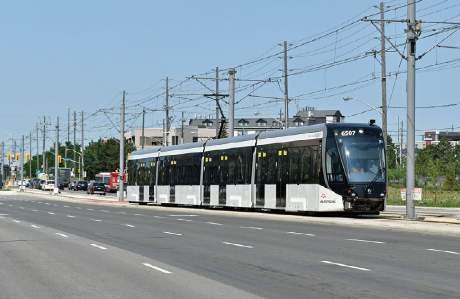
trams 323-326. There is an option for eight more. TP
WARSZAWA (Warsaw). A new 6.5km (four-mile) line to Zielona Białołęka (Grodzisk) is to be built in 2028-30. A library offering over 16 000 books has opened in Kondratowicza metro station. notesfrompoland.com
ROMANIA
BUCUREȘTI (Bucharest). The 1.6km (0.9-mile) northern metro extension of line 2 from Pipera to Petricani has been approved. economica.net
CLUJ-NAPOCA. Work on a launch shaft for two Tunnel Boring Machines, to be used to cut new metro tunnels, started on 11 August. TP TIMI Ș OARA. Armonia trams have taken over operation of line 7, bringing the end of ex-Bremen Hansa GT4 trams. transphoto.org
RUSSIA
KALININGRAD. Tatra KT4 438 has been refurbished. A further four are to undergo the same treatment. J. Carpenter KRASNODAR. New Sinara T811 low-floor bogie tram 630 was destroyed by fire on 21 August. transphoto.org
MOSKVA (Moscow). Tram 30641 is the lead car from the order for 100 PKTS 71-911EM bogie trams. They are to work new line 90 (Akademika Sakharova Prospect – Metro Komsomolskaya). This 1.6km (0.9-mile) line carried its first passengers on 10 September. Troitskaya metro line 16 was extended by 9.7km (six miles) from Novatorskaya to ZIL on 13 September.
A newly-built depot at Stolbovo with stabling for 29 eight-car metro trains has been opened. transphoto.org
YEKATERINBURG. The new three-section 71-639 Kastor trams from Ust-Katav are 850-857. transphoto.org
BRATISLAVA. A parade on 27 August to mark 130 years of tramway operation featured the following: two-axle cars 18 (BEUS, 1937), 31+135 (BMEZ, 1938), 38 (DPMB, 1958) and 104 (Ganz, 1910). It also featured the following Tatras: T2 215, T3 275, K2 317, T3s 7703+7706/ 7733+7734/7819+7820, T6s 7929+7930/7953+7954 and K2 7103. Present were Škoda 29T 7450 and 30T 7501. transphoto.org
MADRID. The southern section of metro Ring line 6 reopened on 6 September after conversion to automatic train operation. The Moncloa – Legazpi section had been closed for four months. BS
STOCKHOLM. Operator SL has exercised its option to order ten more Stadler X15p trains for the 891mm-gauge Roslagsbanan, at a cost of CHF94m (EUR101m). IRJ
BASEL (BLT). Line 14 is cut back from Pratteln until 23 November to permit infrastructure work. Services will terminate at MParc. GENÈVE (Geneva). The turning circle at Nations is out of use for three years while extension construction work takes place. There is a temporary reversing crossover at College Sismondi. BS
LUZERN – INTERLAKEN (ZB) . Stadler has been given a CHF193m (EUR207m) contract for five more ABeh 150 ADLER rack units and three more ABeh 160 FINK units.
ORBE – CHAVORNAY (TRAVYS). Passenger services will temporarily cease with the end of the December timetable, while modernisation work and a change of voltage (700V dc to 15kV ac) takes place. TR

ZÜRICH. Flexity 4082 was delivered in late August. Tram 2000 cars 2048/54/57/65/6768/72-73/78/82/84, 2401/09/18/20 were still in service in September. Cars 2005/80/89 are used for driver training.
Two new Garaventa-built 33-passenger cars for the 385m Rigiblick cable tramway entered service when the line reopened on 26 September. VBZ
IZMIT. The 1.4km (0.9-mile) Otogar – Sakıp Sabancı Blv MTAL tramway extension opened on 22 August. A further extension to Kocaeli Stadyumu is under construction. urbanrail.net
UNITED KINGDOM
BLACKPOOL. HMS Blackpool and one Balloon tram are to return to service throughout the Lightpool Festival (on 15 October-1 November).
EDINBURGH. There will be greater integration between Edinburgh Trams and Lothian Buses following the appointment of Sarah Boyd as Chief Executive of both. An integration agreement is set to follow.
GREATER MANCHESTER. Metrolink’s programme of track renewals continues throughout October. The Ashton and Bury lines were to be affected on 5 October and the Victoria and Bury lines on 19 October, while the Bury line was to be closed on 25-30 October.
LONDON (DOCKLANDS). The first B23-Stock has started daytime testing. The trains are due to enter service later this year.
B07-Stock 125 has received a new wrap livery that marks 25 years of Transport for London.
LONDON (GENERAL). The London Borough of Waltham Forest has issued a tender to turn Hatherley Mews, which includes a former London Transport tram
workshop, into offices and retail spaces.
LONDON (TRAMS). A power cut at Therapia Lane Depot on 25 September closed the network for a day. There was still severe disruption the following day.
London is to be the next system to trial the VibeSafe warning system. Developed by Efficiency Ups Ltd, this sends vibrations through the rails to warn pedestrians of an approaching tram. The next phase of testing will evaluate whether warning sirens or lights, or a combination of both, is most effective.
BALTIMORE, MD. Maryland Department of Transportation issued its draft budget for 2026-31 on 2 September. It includes USD1.4bn (EUR1.2bn) for the modernisation of the existing light rail line, which opened in 1992. J. May
CAMDEN – TRENTON, NJ. New Jersey Transit is to take over the 54.4km (34-mile) River Line diesel light rail service from Alstom by the end of the year. J. May
CHARLOTTE, NC. US Secretary of Transportation Sean Duffy declared that transit networks across the country were hotbeds of violence, in the wake of the fatal stabbing of a 23-year-old female Ukrainian refugee on a light rail train. He has threatened to pull federal funding from transport operators unless plans to deter crime and fare evasion are formulated. W. Heger DALLAS, TX. The 41.6km (26-mile) Silver line is to open on 25 October. Tickets on the Plano – DFW airport line were to be free until 8 November. Services will be provided by eight Stadler Flirt diesel units, providing a 30-minute peak service (hourly off-peak). There is interchange with the DART Red line at Cityline/Bush and with the Green Line at Downtown Carrollton. J. May
LARKSPUR – CLOVERDALE (SMART), CA. A Stacy Witbeck/ Herzog joint venture has won the USD21.7m (EUR23.2m) contract to build the 14.4km (nine-mile) diesel light rail line extension from Windsor to Healdsburg. Completion is expected in late 2028. J. May NEW JERSEY, NJ. NJ Transit has exercised its option with Alstom to order 200 more double-deck commuter carriages and 12 electrodiesel locomotives, worth around USD1bn (EUR856m). Seat capacity on services between Hoboken and Penn Central will be increased by 12% when the whole fleet enters service in 2031. There is a remaining option for 50 cars. RGI NEW YORK, NY. The congestion charging scheme has resulted in a 12% reduction in traffic through Manhattan. Subway use has increased by 9% and bus use by 13%.
raise GBP30 000 (EUR34 350) to complete the restoration of its Q Stock EMU has passed the halfway point. It was launched in May. The money is needed to pay for new moquette for the seats.
BEAMISH (UK). Newcastle tram 114 is being repainted. Blackpool 31 has been withdrawn with damaged truck bolster side plates. New ones are to be made. Brakegear and motors are being refitted to Gateshead 10.
BRIGHTON (UK). The Volk’s Electric Railway Association celebrated its 30th anniversary with a special event on 20-21 September. CRICH (UK). Blackpool ‘Box Car’ 40 has returned to service.
LOWESTOFT (UK). Brush ‘Terror Tram’ 634 returned to service after a minor electric fault was fixed. It ran with Blackpool Marton VAMBAC 11 on selected dates in September.
Mass Transit
The MTA Staten Island Railway fleet is now completely upgraded to R211S cars. Some R44s remain in reserve.
PHILADELPHIA, PA.
Southeastern Pennsylvania Transportation Authority was ordered to halt planned service cuts and a 1 September fares increase after a court hearing on 29 August. The plans were found to be discriminatory towards poor and minority communities. The service cuts were reversed but fares did increase slightly on 14 September. This has resulted in USD394m (EUR337m) of the capital expenditure budget being reallocated to revenue support.
Mass Transit
SACRAMENTO, CA. Sacramento Regional Transit and the city of Elk Grove have partnered to produce plans for alternative alignments for the Blue light rail line extension.
Mass Transit
SAN BERNADINO, CA. A hybrid hydrogen fuel cell/battery electric Stadler Flirt entered service on the 14.4km (nine-mile) Metrolink Arrow line to Redlands on 13 September. There is an option for the purchase of three more.
Mass Transit
SAN FRANCISCO, CA. Bay Area Rapid Transit’s system was unable to operate until 12.30 on 5 September after the effects of an overnight computer upgrade prevented the dispatch of trains.
J. May
NORTH SHIELDS (UK). Nexus and Stadler have arranged for pioneer Tyne and Wear Metrocar 4001 to be preserved at the Stephenson Railway Museum. Meanwhile, 4019 has been donated to Tyne and Wear Fire and Rescue Service for training.
POZNA Ń (PL). Restored twoaxle tram 178 was launched on heritage line 23 on 6-7 September. The vehicle spent some time as works car 2024. TP SAN FRANCISCO, CA (US). The Western Railway Museum is trying to raise USD15 000 (EUR12 847) to ensure the preservation of Muni Breda LRV 1534. WRM SEATON (UK). The 838mmgauge tramway celebrated its 55th anniversary on 23-24 August.
WARSZAWA (Warsaw) (PL). WKD EMU EN95-001, the first EMU manufactured by PESA in 2004, has been preserved by a local museum after several years out of service. TP
Worldwide items for inclusion should be sent to Michael Taplin at Flat 8, Roxan Villa, 33 Landguard Manor Rd, Shanklin, Isle of Wight PO37 6EA, UK. Fax: +44 (0)1983 862810 or e-mail miketap@mainspring.co.uk UK and Ireland items, please e-mail uknews@lrta.org
TACOMA, WA. The Tacoma Link tram line has increased its patronage to 4079 average monthly boardings compared with 3618 last year.
MUSEUM NEWS
J. May
ACTON (UK). The London Transport Museum’s appeal to
Acknowledgements are due to: abc.net, Blickpunkt Straßenbahn (BS), cs-dopravak, dopravak.eu, dit.sa.gov. au, Facebook, haagsetrtamnieuws. org, International Railway Journal (IRJ), lineoz.net, Mass Transit, notesfrompoland.com, Op de Rails (OR), Railway Gazette International (RGI), skyscrapercity, Today’s Railways (TR), Tram-2000 (T-2000), tramwayforum.at, transphoto.org, Transport Publiczny (TP), urbanrail. net, VBZ and WRM.


By Colin Robey and Paul Rowen
On Tuesday 22 July at the UK Light Rail Conference in Leeds, UK Tram, Mainspring and the Light Rail Transit Association launched a joint initiative to attract and develop the future staff of the light rail industry. A panel debate was held that was chaired by Colin Robey, and comprised several young professionals including Robyn McSharry of the LRTA, Anna Tyler of Mott MacDonald, Sandeep Kaur Dulay of West Midlands Metro, and Jonty Cullinan of the University of Warwick. They were supported by Sarah Turner MD of Nottingham NET and Tim Kendell, Technical Director of the LRTA.
The group responded to numerous questions and discussion points raised by a very large audience. All the panellists took an active part in the discussions and the audience could not have failed to be impressed by the confidence with which they answered the questions.
“It was unfortunate and not a little ironic that the launch of this initiative took place
on the same day as the funeral of Geoffrey Claydon, who had worked so tirelessly to introduce legislation to allow young people to undertake work experience in the tramway world. I’m sure he would have approved,” Colin Robey commented.
This was the second time Mainspring had organised a panel discussion by young people at the UK Light Rail Conference, which led to the joint decision to develop the Rising Stars Programme.
The UK’s second-generation light rail systems are now firmly established, and with Leeds and others on the horizon, there is a pressing need to develop the next generation of light rail professionals. In an increasingly global market and with competition from many sectors, leaving it to chance is no longer an option. As part of this process, UK Tram has formed a working group comprising sponsors, operators, engineers, private sector companies and universities,
as well as Network Rail. Together they are developing a route map of apprenticeships, graduate placements, secondments and work experience opportunities.
A link with a sixth form college in Greater Manchester with Metrolink will provide work experience placements next summer. Further links and opportunities with schools and colleges are also planned.
Why are the LRTA and Mainspring involved?
Since its inception the LRTA (or LRTL initially) has always had close links with those who operate and run our light rail systems. Many professionals have been and are members of the Association. Developing a thriving pipeline of professionals to plan, develop and run light rail is therefore central to its aims.
Mainspring not only publishes TAUT, but also delivers the Global Light Rail Awards – which includes a Rising Star Award – and organises the annual UK Light Rail

Conference, along with playing a crucial role in the industry.
Developing and broadening training opportunities for existing staff from Level 2 through to degree courses is being discussed with the Chartered Institute of Railway Operators. The CIRO is looking at ways to widen its understanding of light rail through the mixed use railway initiative. Providing an opportunity for a career in both heavy and light rail has got to be a win-win for everyone – industry and young people.
• Membership of the LRTA
• A digital copy of Tramways and Urban Transit every month – the leading light rail magazine
• Access to the monthly online talks organised by the LRTA, which include leading members and campaigners.
• Opportunity to attend in-person meetings and trips locally and nationally
• Free entrance to the National Tramway Museum at Crich
• A confidential online chat for Rising Star members to discuss their thoughts
• Further training programmes organised by UK Tram and the CIRO
The programme is open to anyone aged 18-35 working in the industry across all departments and disciplines, from apprentices to graduates. Further details can be found on the LRTA website. Employers can nominate individuals, or individuals can put themselves forward using the form available on the website, or by e-mailing: risingstars@lrta.org stating name, age, employer and e-mail address.
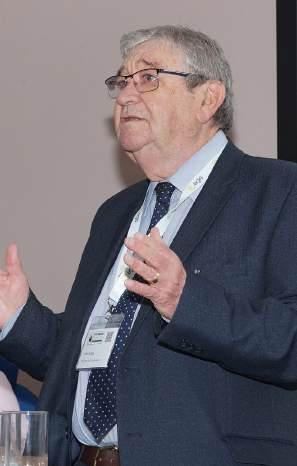
“Geoffrey Claydon, whose funeral was on the same day, worked tirelessly to introduce legislation to allow young people the opportunity of work experience in the tramway world. He would have approved.”
Tuesday 4. Southampton 19.30. AGM + members’ digital slides. Junction Church (Former Railway Institute), Romsey Road, Eastleigh, GBP3. (LRTA/SEG)
Monday 10. Leeds 19.30. Malcolm Hindes: Leeds Trams Remembered (Film from the LTHS Archives).
The Engine House Middleton Railway, Moor Road, Leeds, LS10 2JG. GBP1 (includes light refreshments) Contact: enquiries@lths.co.uk. (LRTA/LTHS)
Wednesday 12. Sussex 19.40. Andrew Marshall; Railways in the Landscape. Southwick Community Centre, Southwick, BN42 4TE. Contact: sussex@tlrs.info GBP2 visitors. (SEG)
Saturday 15. Taunton 14.00.
Robert Manders: How do we get there? or... How do transport companies communicate with us?
West Monkton Village Hall, Monkton
Heathfield, TA2 8NE. Contact westofengland@tlrs.info. GBP2 inc. light refreshments. (TLRS)
Monday 17. Solent 19.30. Early Christmas bash + members slides / videos. St. Nicholas’s Church Hall, Wickham, Hants, PO17 6HP. Contact: solent@tlrs.info. GBP2. (TLRS) Monday 17. Liverpool 19.30. Martin Jenkins: Jim Joyce films 1951-1955 plus Liverpool Trams in 1955. Sefton Park Community Association, 3 Croxteth Drive, Liverpool, L17 3AG merseyside@tlrs. info. Cost GBP4. (TLRS/MTPS)
Thursdsy 27. Manchester 19.00, Robert Pritchard, Prague 150th Anniversary. Friends’ Meeting House, 6 Mount Street, Manchester M2 5NS (near St Peter’s Square Metrolink station). Contact manchester@lrta.org. GBP4 donation requested on the night to cover the cost of the room hire. (LRTA) Saturday 29. Nottingham 14.00. John Huddlestone: Derby
Congratulations to four of the rising stars who co-presented at this year’s Global Light Rail Awards in London at the start of October.
Sandeep Kaur Dulay from West Midlands Metro, Hannah Crookall from TXM Consult, Phil Page from Tram Operations Limited, and the Global Light Rail Awards’ own Sophie Johnston did a brilliant job in presenting what is the light rail industry’s most prestigious event.
“I was impressed by both their confidence and professionalism,” said Paul Rowen, LRTA Chair. “They are definitely people to look out for!”
A full report on this year’s Global Light Rail Awards will appear in December’s issue of Tramways & Urban Transit.

Compiled by the LRTA. For a full list of the year’s events and meeting places, including online meetings, visit www.lrta.org
Trolleybuses. Beeston Scout Hut, NG9 1GA. Contact: chair@tlrs.info (TLRS)
Saturday 29. Garstang 14.00. Tony Young: A review of the year’s LRT and trams. St Thomas New Church Hall, Church Street, Garstang PR3 1PA. Contact archivist@tlrs.info Small fee light refreshments. (TLRS)
Saturday 29. Coatbridge, 13.00. Scottish trams show and tell & talk TBC. Cumbernauld Theatre, South Kildrum, Ring Road, Cumbernauld, Lanternhouse G67 2UF. Contact: scotland@tlrs.info. (TLRS)
Tuesday 2. Southampton 19.30. Steve Dungay finds some more fascinating north American webcam material. Junction Church (Former Railway Institute) Romsey Road, Eastleigh, GBP3. (LRTA/SEG)
Monday 8. Leeds 19.30. Andrew Gill: “Harold Smith” 1910 Bradford
trams. The Engine House Middleton Railway Moor Road Leeds LS10 2JG GBP1 (includes light refreshments) Contact: enquiries@lths.co.uk. (LRTA/LTHS)
Monday 8. Liverpool 19.00. Annual festive meal. Advance bookings only. The Richmond Tavern, 23A Church Road, Liverpool L15 9EA. merseyside@tlrs.info. Cost GBP25. (TLRS/MTPS)
Wednesday 10. Sussex 19.40. Christmas social evening. Southwick Community Centre, Southwick, BN42 4TE. Contact: sussex@tlrs.info. GBP2. (TLRS/SEG) Saturday 20. Nottingham 14.00. Tramway films. Beeston Scout Hut NG9 1GA Contact: chair@tlrs.info. (TLRS)
Saturday 20. Coatbridge, 13.00. Scottish trams show and tell & talk TBC. Cumbernauld Theatre, South Kildrum, Ring Road, Cumbernauld, Lanternhouse G67 2UF. Contact: scotland@tlrs.info. (TLRS)
This issue we begin an occasional series reviewing tramway museums in the USA. We start in the north of this vast country, with the all-volunteer Minnesota Streetcar Museum.
Mike Russell reports.
At the extreme south of the State of Minnesota is a small but interesting and smartlypresented heritage operation.
Located in the urban metropolis of Minneapolis and St. Paul, collectively known as the Twin Cities, it uses the tracks or rights-of-way of the former streetcar lines of the Twin City Rapid Transit Company (TCRT).
The area is not untypical of much of North America in that the original streetcar lines were mainly abandoned in the years following World War Two, but in that a renaissance of light rail has since taken place. It began here in 2004 and now features two lines, the first of which recreates a through service between the two cities. These operations are complemented by those of the Minnesota Streetcar Museum, an operation ‘spun off’ from the Minnesota Transportation Museum in the early years of this century. Operations here are quite unusual in being two completely separate standard-gauge (1435mm) lines under the same ownership, with only a small number of cars and very little exchange between the two.
The longer of the two heritage lines is the Como-Harriet Streetcar Line, in south-west Minneapolis. This extends for around one mile (1.6km) wholly on reserved track and at one point abutting Lake Harriet on its west side, once a much-frequented leisure area and still very popular today.
Rail transport had arrived in 1880 and by 1891 the Minneapolis Street Railway had electrified the line; by 1906 it had been double-tracked by the TCRT and extended to Excelsior on Lake Minnetonka. The cross-city line, by now serving central Minneapolis and St. Paul as well as the University of Minnesota, was abandoned in June 1954, but in 1971 the present section of line was reopened. This used single track with a passing loop at Linden Hills station (a replica of the 1900 structure) and a depot was later built at its southern end, with workshop facilities and archival space facilitating the museum’s preservation and recording of the history of former Twin Cities tramways.
All tramcars operating on this and the Excelsior line are of local origin, and the first to run on the reopened Como-Harriet section was 1300. This was built by the TCRT’s new Snelling shops in St Paul in spring 1908, as one of 19 impressive bogie cars designed to speed up the service on the inter-city University Avenue line. It remained in
service until 1954, becoming one of the last streetcars to operate in the Twin Cities, and frequently served the Como-Harriet line. It is now presented as rebuilt in the early 1930s in a form to allow both one-man and crew operation.
Another car of similar vintage is 1239 which, as one of the last built in the old 31st Street shops in spring 1907, was fitted with three sets of wire gates at the rear, where passengers boarded and alighted. This arrangement was dispensed with when the car was rebuilt in 1935 to facilitate both oneman and crew operation and sets of folding doors were fitted both front and rear. After withdrawal in 1953 it served as a cabin until recovered by the museum in 1987, where it has been restored to ‘as built’ condition as a gate car. Originally operated at Excelsior, this car is now allocated to the Como-Harriet line.
The third streetcar at Como-Harriet is the sole PCC vehicle in the fleet. Car 322 was built by the St Louis Car Company in 1946, one of a fleet of 140 cars delivered to TCRT in an unsuccessful attempt to revive the company’s tramway fortunes. In 1953, it passed to the Newark subway system. In 1978 it moved to the Shaker Heights Rapid Transit line in Cleveland but was later brought back to the Twin Cities and after extensive restoration returned to service in 2000.
Tramcar service on the Como-Harriet line operates on Wednesday and Friday afternoons from early June to the end of August; on Wednesday, Thursday and Friday evenings (18.30-20.30) from early June to the end of August; and Saturdays and Sundays 12.30-19.00 (September), 12.30-20.30 (May to August) and 12.30-16.00 (October). The PCC car is scheduled to operate on Thursday evenings and all day on Sundays. There is no fixed timetable, service operating on demand – normally about every 20 minutes. Fares are USD3 for a single ride or USD7 for a day pass valid on both lines; children aged three and under travel free. Visitors should note that to preserve these vintage cars there is liable to be no service during rain.
We move now to the Excelsior line, located in the city of Excelsior south-west of Minneapolis. This is the shorter of the two lines, about 800m (0.5 miles) in overall length, and there is a less frequent service than on Como-Harriet; the lines are laid on a section of the former Minneapolis and St Louis Railway. As the line is single-track, only one car operates at any one time. The main performer is 265, built in 1915 in
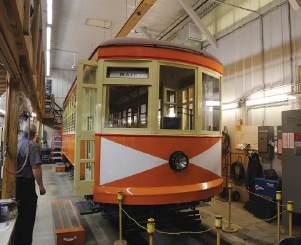
1
TCRTC’s Snelling shops as 1791 and passed on in the following year to the Duluth Street Railway Company as that organisation’s 265; it survived there until abandonment in September 1939. The car body, later discovered in use as a summer cabin in Wisconsin, was restored by the museum to its 1929 appearance; this was a ‘ground-up’ restoration as no electrical components existed and the interior was gutted. In 1982 the car returned to service on the ComoHarriet line. A noteworthy feature of this car, not uncommon amongst early electric cars operated on systems in the ‘high north’ tramway latitudes, is the wood-burning stove at the front of the saloon behind the motorman. Other examples of this early form of saloon heating can be found in museums at Halton (Canada) and St Peterburg (Russia). A prized possession is Duluth Street Railway Company double-ended two-axle car 78. Duluth, a major port city on the shores of Lake Superior north-east of the Twin Cities, operated electric tramways from 1890 until 9 September 1939. Car 78 was built in 1893 by the Laclede Car Company and was in service until 1911; it is one of the oldest operable preserved electric streetcars in the United States and its restoration was carried out by museum members. It currently operates on the Excelsior line.
Tram 10 was built in 1913 by the St Louis Car Company as a typical small, doubleended car run by smaller cities in the first decades of the century; this example was operated in Winona, Minnesota, by the Mississippi Valley Public Service until that system was abandoned in 1938. It appears in a striking livery of orange and cream with off-white triangular flares to the dash panels. Operation at Excelsior is more restricted than at Como-Harriet. The 2025 timetable provided for service on Thursdays between 12 June and 2 August; Saturdays 3 May27 September: and Sundays 25 May-21 September. Fares are to the same scale as at Como-Harriet.
The Excelsior line is located in downtown Excelsior on Water Street between Third and George Streets. Approach from Minneapolis is via Highway 7. Visitors to the Como-Harriet line should take the LRT to Warehouse District and walk back to and right into Hennepin Avenue for bus 6D or 6E. For the north end of the line alight at Richfield Road, Trolley Stop, journey time about 28 minutes. Linden Hills is only reached every 30 minutes via route 6D, alighting on Sheridan Avenue South and walking two blocks east on West 42nd Street.
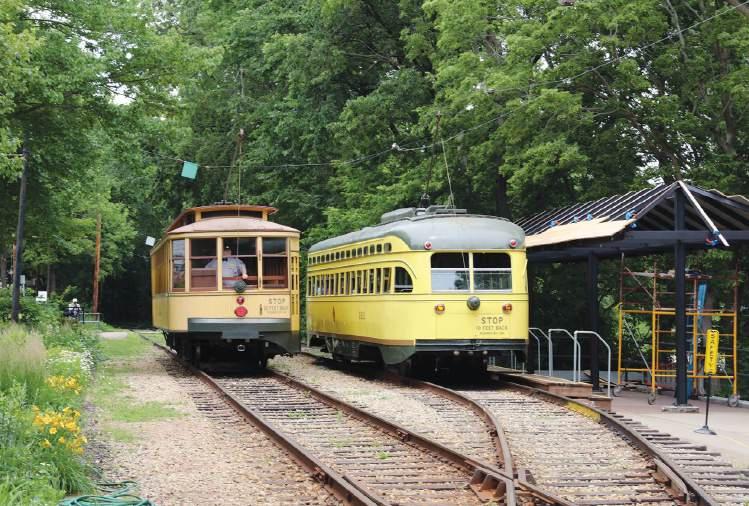

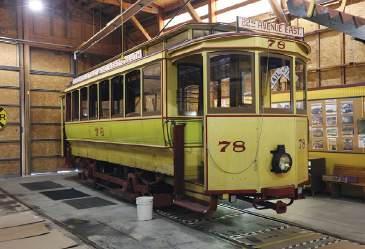


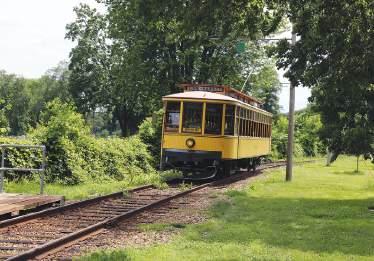
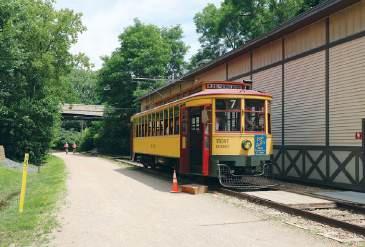
1. Winona 10 is a four-wheel car dating from 1913 which, at the time of the visit, was at the end of a rehabilitation programme. It is depicted in the Excelsior line depot.
2. The passing loop at Linden Hills station on the ComoHarriet line during a rare occasion when two cars were in operation. On the right is PCC 322 heading north on a private railfan charter whilst the regular public service is performed by car 1300, now 117 years old and extremely well dressed for such an old lady. Car 322 has a proper back-up controller, whilst the non-PCC cars operate southbound with trolley pole leading and an improvised mechanism for series-only low-speed travel.
3. An interior view of the front of car 265 showing (left) the substantial wood-burning stove for winter heating. Purchase and installation of this item was apparently one of the most expensive features of the car’s entire restoration.
4. PCC car 322 in the loop at Linden Hills ready to depart to the northern terminus of the line at Brookside.
5. Duluth 78 is a four-wheel car with hexagonal-dash bodywork built by the Laclede company in 1893 and is now one of the oldest operational electric trams in the entire USA. It is shown here in the Excelsior line depot.
6. TCRT-built car 1300 of 1908 approaches the northern terminus of the line at Brookside. Access to the line is by motor bus from central Minneapolis, with stops on the adjacent road close to the tram terminus.
7. A long-term restoration project in the Excelsior depot is that of Masaba Railway Company 10, a massive bogie car built by the Niles Car Company and dating from 1912. It was in operation until 1927 between Hibbing and Gilbert, Minnesota.
8. Bogie car 265 is currently a main performer on the short Excelsior line. Here the fares include the opportunity to visit the car barn (depot), alongside which 265 is parked whilst the passengers inspect the premises and cars within. A small gift and souvenir shop is included in the building.
All photography by Mike Russell on 28/29 June 2025.

Celebrate the achievements and milestones of the light rail industry –a full report to showcase the stars of this year’s awards ceremony in London.

Andrew Thompson visits the Slovak capital to see how a new extension has transformed mobility in one of Europe's most densely populated districts.
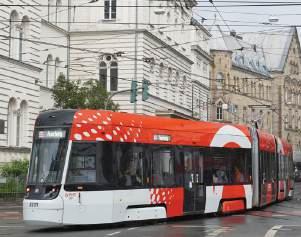
Neil Pulling visits Germany's Bonn system which has surface and underground route, integrating tram and Stadtbahn on both banks of the Rhine.
+ Track technology and safety
+ Classics: Praha celebrates 150 years of trams
+ The latest news and analysis, system and technical development



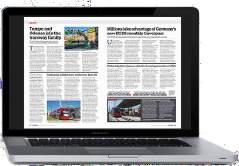


Order online from www.lrta.info/shop – or by post from:
LRTA Publications, 38 Wolseley Road, SALE, M33 7AU
(Please provide telephone contact details and quote LRTA membership number if applicable)
Outside UK = Airmail to Europe (includes all of Russia) / Surface mail to rest of world; Airmail Zone 1 = outside Europe excluding Australia, New Zealand & USA; Airmail Zones 2/3 = Australia, New Zealand & USA

Ghent, 150 years of tramways
Memories of yesterday
A superb record of the events of May 2024 when the city celebrated its century and a half of tramways in grand style. Includes brief notes on each of the cars in the parade.
English and French text.
> A4 hardback; 56 pages; 96 mainly colour pictures.
£31.00 (UK addresses); £38.00 (outside UK); £44.00 (Airmail Z1);
£48.00 (Airmail Zones 2 and 3); LRTA Members: £2.80 discount

Bruxelles – Vossem – Terveuren – Leuven (Louvain)
Explores the history of the lines to the east of the Belgian capital from early years steam traction through electrification completed in 1937 to the closures between 1954 and 1961. French text.
> A4 softback, 78 pages, 100+ pictures mainly in black & white, 14 maps.
£31.50 (UK addresses); £36.50 (outside UK); £40.00 (Airmail Z1);
£42.50 (Airmail Zones 2/3); LRTA Members: £2.80 discount
Liège en tram
Un heritage retrouvé – un avenir en mouvement

A comprehensive review of the complex tramway history of the city, with its extensive networks that survived until 1968. Trolleybuses (until 1971) and the interurban line to Seraing are covered together with the new tramway. French text.
> A4 hardback; 112 pages; 100+ black & white and colour pictures, three maps.
£36.00 (UK addresses); £47.00 (outside UK); £59.00 (Airmail Z1);
£62.00 (Airmail Zones 2 and 3); LRTA Members: £3.20 discount
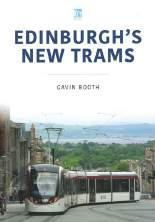

i Norrköping
De senaste tjugo åren | 2004-2024
Detailed review of this small but progressive Swedish system’s last 20 years, in which a significant line extension and new trams have featured. Swedish text.
> A4 hardback; 112 pages, 200+ colour pictures, two maps.
£30.00 (UK addresses); £35.00 (outside UK); £40.00 (Airmail Z1);
£42.50 (Airmail Zones 2/3) (shipping costs reflect despatch from Sweden); LRTA Members: £2.00 discount

Rail track map of Greater Stockholm
Diagrammatically shows the growth of the Tunnelbana metro network alongside four commuter rail lines and five tramlines, plus the Saltsjöbanan and narrow-gauge Roslagsbanan. Swedish and English text.
> 800 x 610 mm, folded in card covers to 210 x 210 mm, in full colour. £24.50 (UK addresses); £30.00 (outside UK); £34.00 (Airmail Z 1); £39.50 (Airmail Zones 2/3) (shipping costs reflect despatch from Sweden); LRTA Members: £1.65 discount

The last years of this city’s tram network are brought to life in nostalgic views of the lines which operated until final closure in April 1973. Includes present day museum line. Swedish text.
> A4 hardback, landscape format; 121 pages, 200+ colour and black & white pictures, four maps.
£35.00 (UK addresses); £37.50 (outside UK); £43.00 (Airmail Z1);
£45.00 (Airmail Zones 2/3) (shipping costs reflect despatch from Sweden); LRTA Members: £2.50 discount
For further details of all these books go to our website.
Edinburgh’s New Trams
British Transport Systems Series Volume 14
A succinct and informative review of the planning, construction and operation of the city’s second-generation tramway, including a stop-by-stop description of the Airport to Newhaven route.
> B5 softback, 96 pages, 200+ colour pictures.
£16.99 – www.keypublishing.com
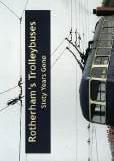
Rotherham’s Trolleybuses
Sixty Years Gone
Published to mark the 53-year story of this system, which operated from 3 October 1912 to 2 October 1965 and included rare (for the UK) joint operation of trolleybus services with the Mexborough & District Traction Company.
> A4 softback, 44 pages, fully illustrated in black & white and colour, six maps.
£10.00 – www.nationaltrolleybus.org

TWO days of interactive debates... TWELVE hours of dedicated networking... ONE place to be
Join key decision-makers, professionals and industry experts as they gather for two days of debate centred upon how new technologies are driving progress in sustainable transport.
For 2026 we are taking the European Light Rail Congress back to the beautiful Canary island of Tenerife, home of the Metrotenerife light rail system.
Metrotenerife provides modern and efficient public transport, with safety and the environment being key factors that contribute to improving the quality of life of the citizens of Tenerife and the surroundings. There are some very exciting expansion plans with their current lines in the North of the Island growing, as well as building new lines to connect more areas of the island and reduce the need for cars and reduce both congestion and pollution.
As an attendee, you will experience: Two days of presentations, panel debates and discussion from some of the sector’s most innovative and forward-thinking suppliers, manufacturers and operators, plus an expansive exhibition hall within the Espacio Mutua Tinerfeña in San Cristobal de la Laguna, which is very close to the tramway. An evening networking reception for delegates to maximise their networking opportunities is also included, along with an exclusive behind the scenes depot tour hosted by Metrotenerife. Convenient accommodation to the venue is very close with one hotel just 4-5 metres away, and another 450 metres away.
With bespoke sponsorship and exhibition packages also available, there has never been a better time to place yourself at the very heart of European light rail.


11-12
March
2026
